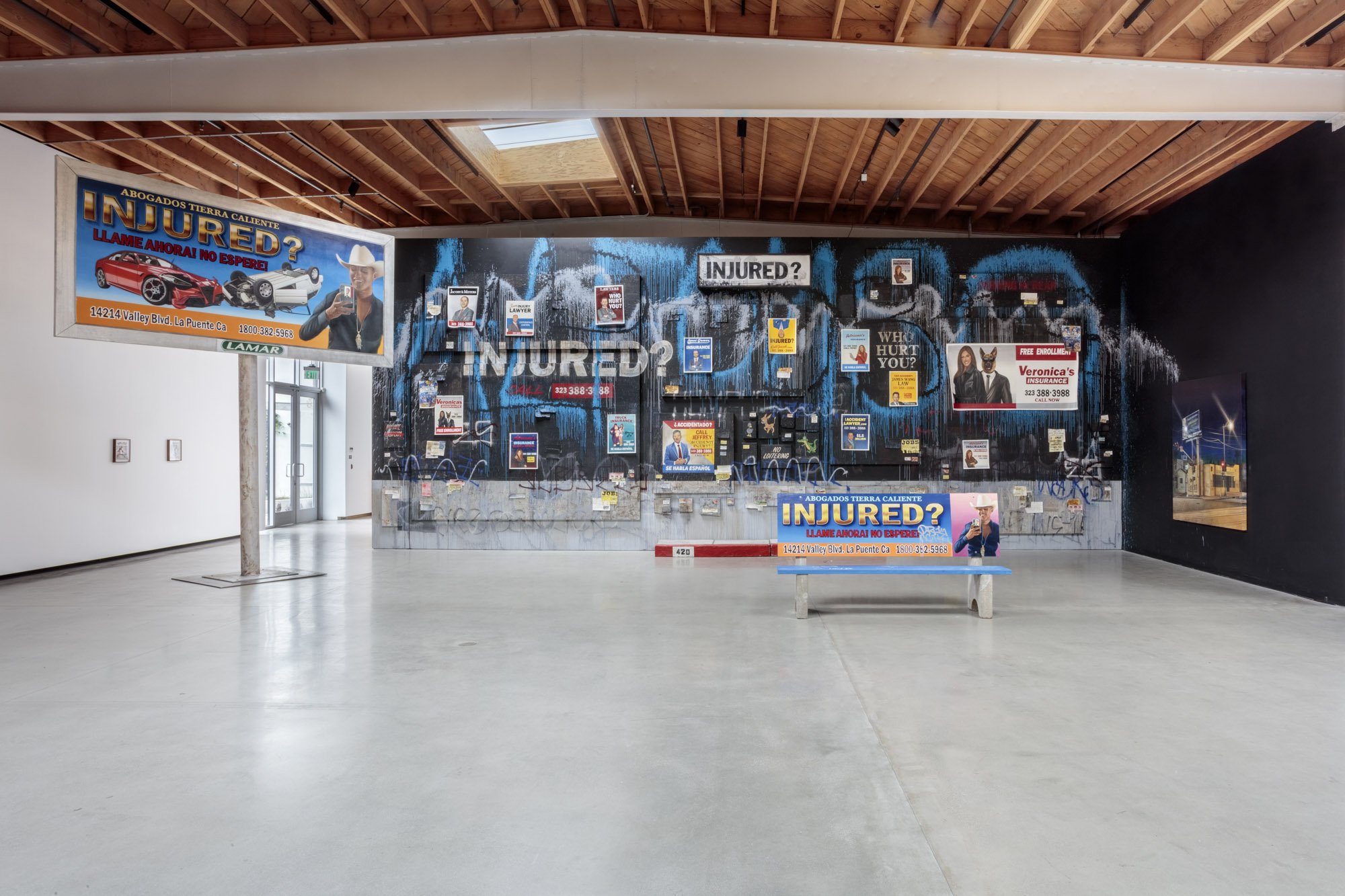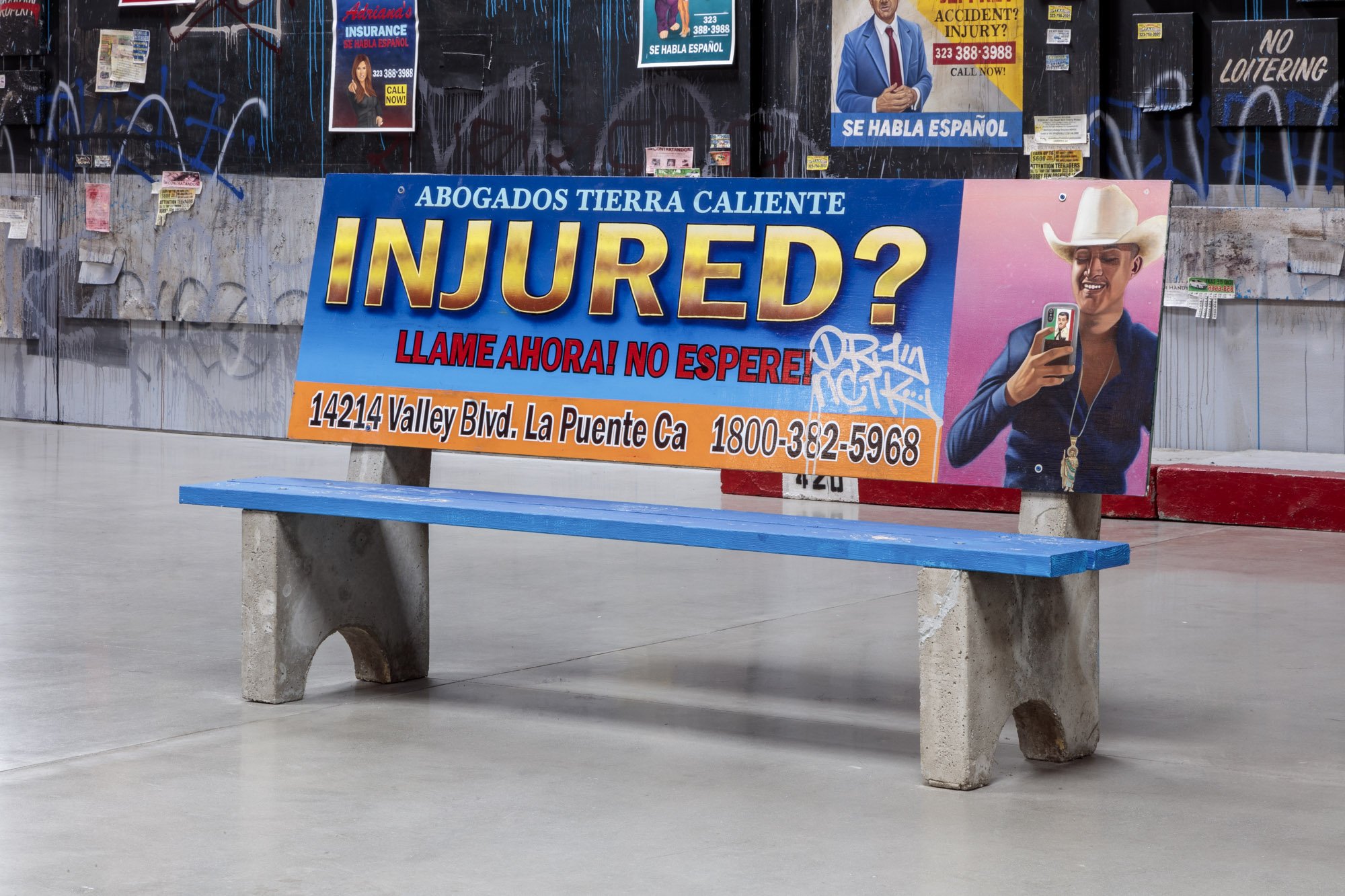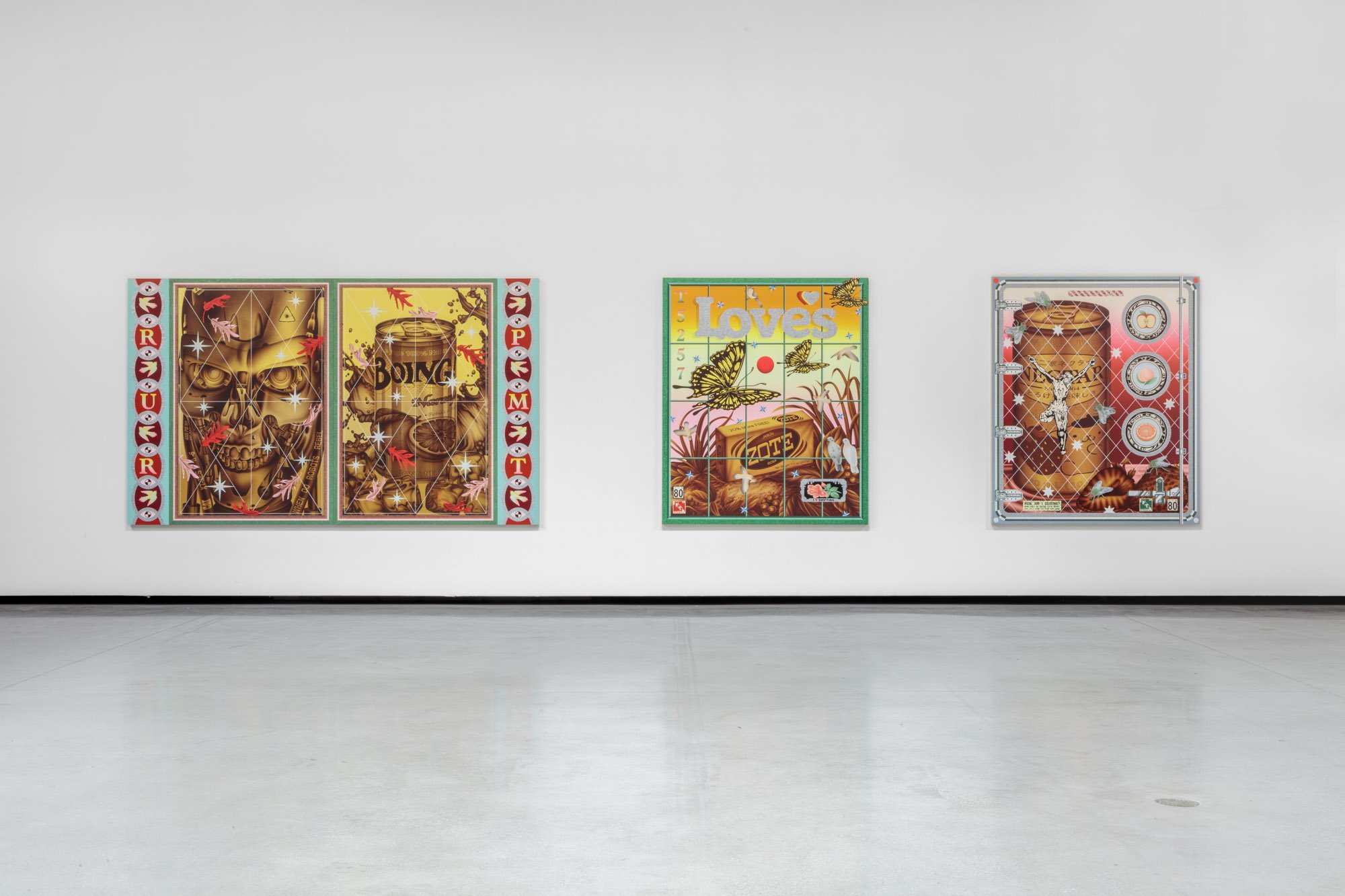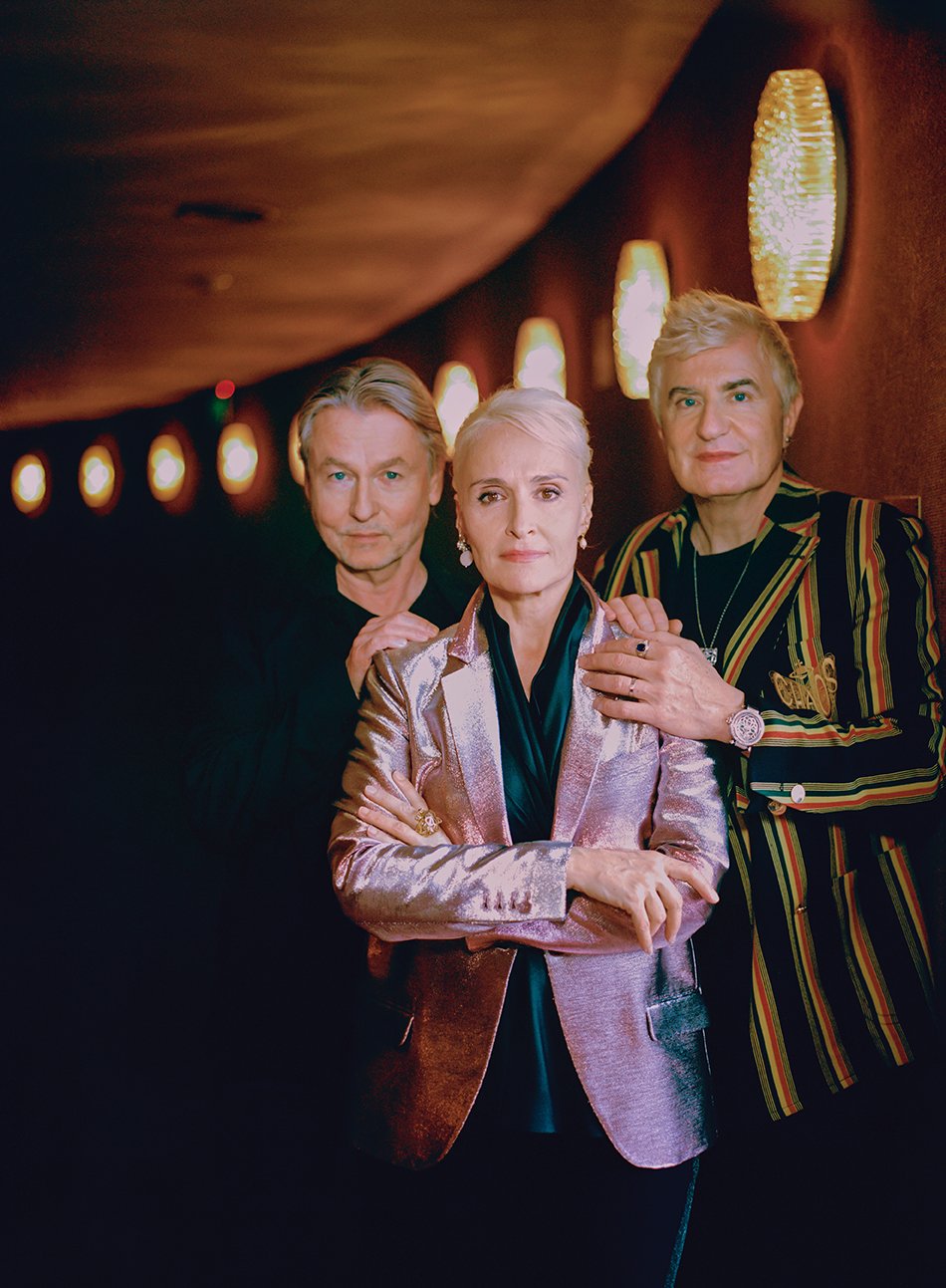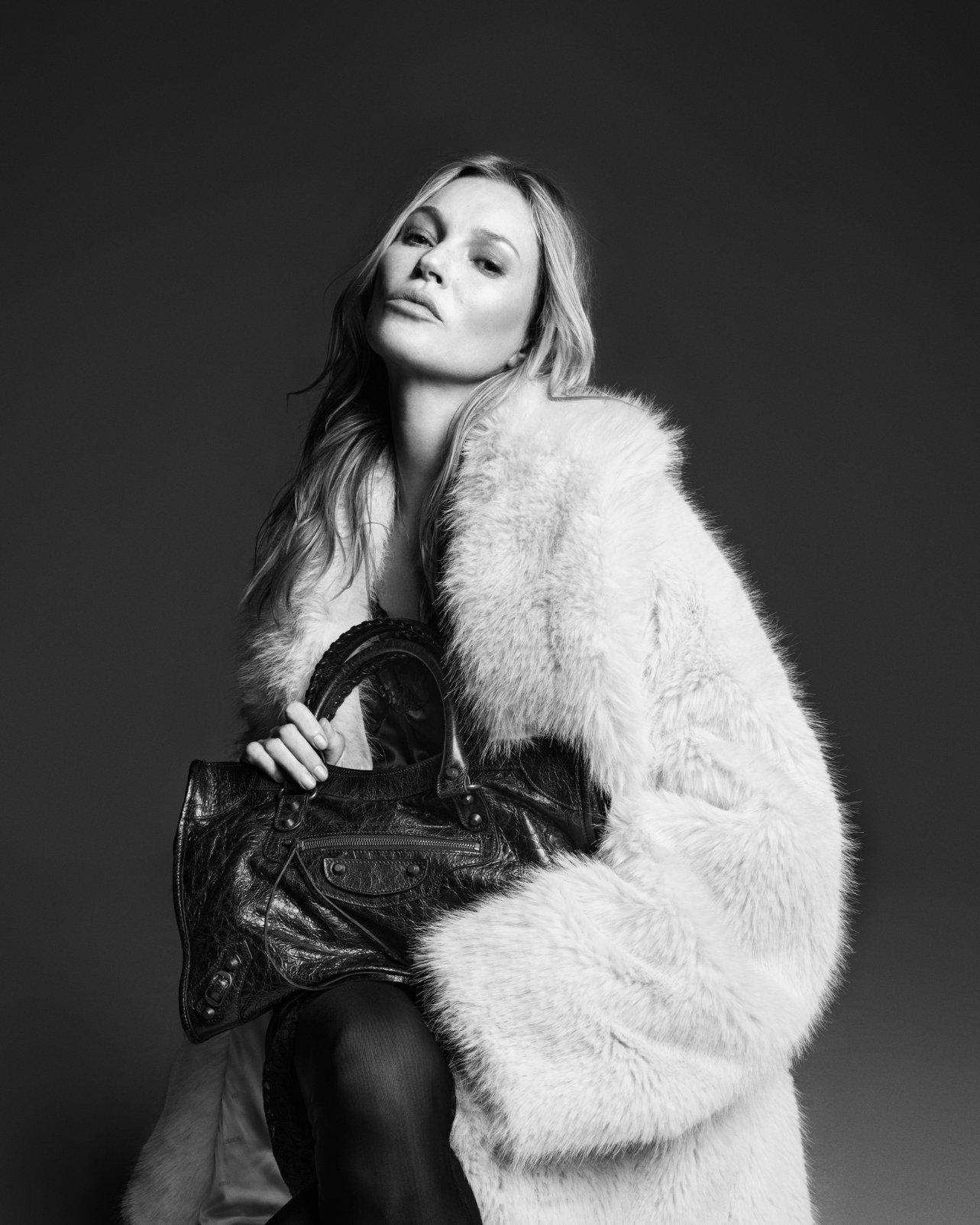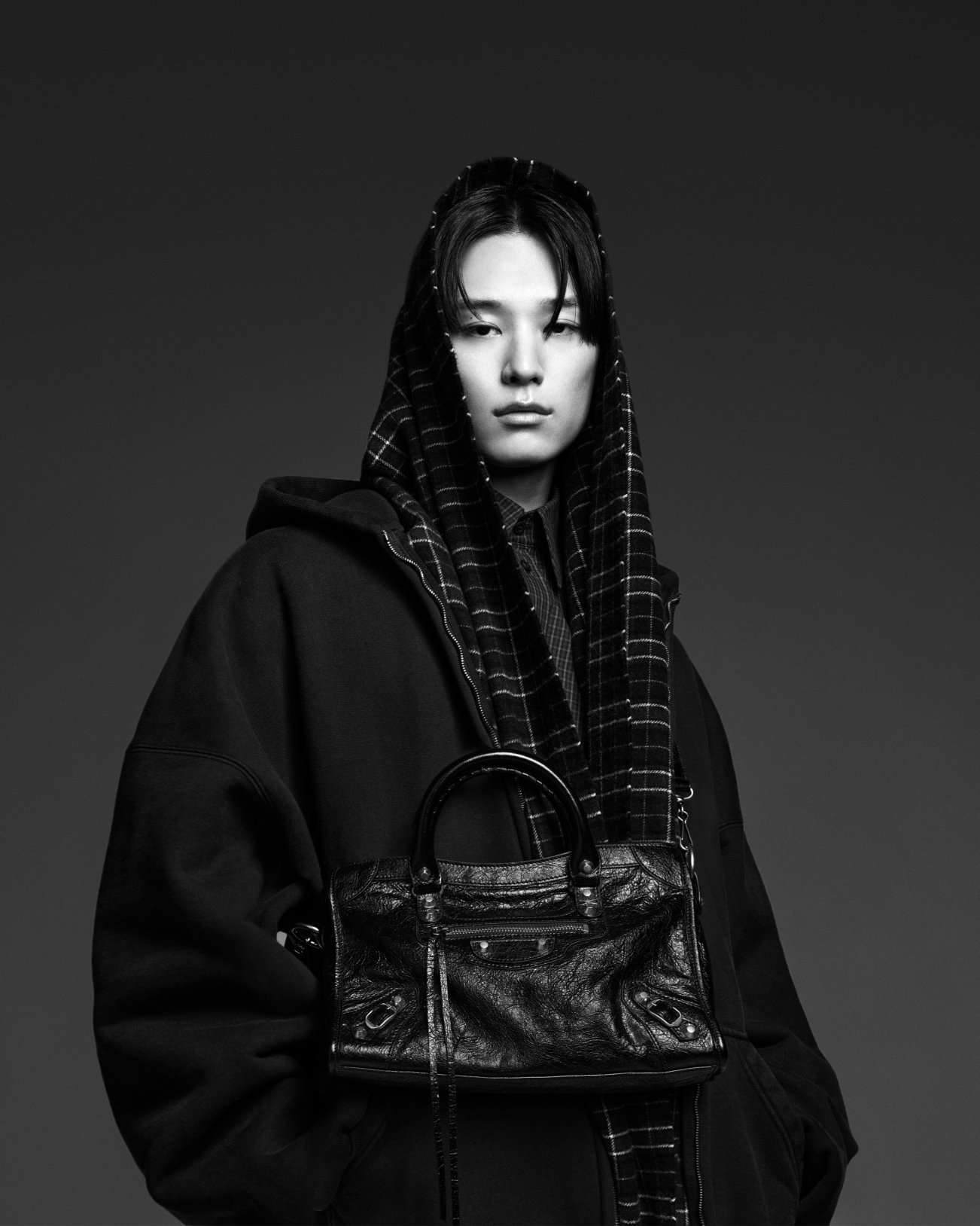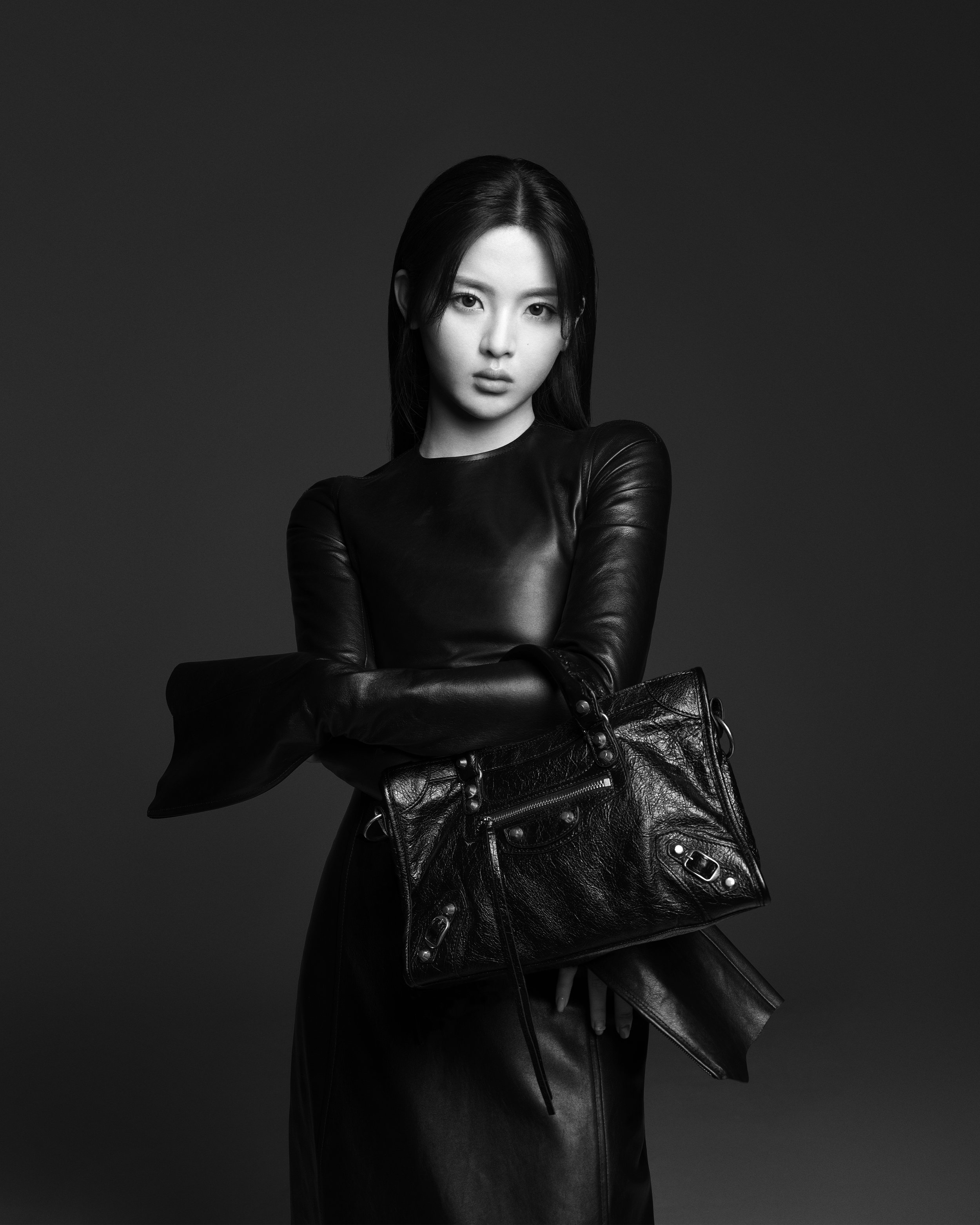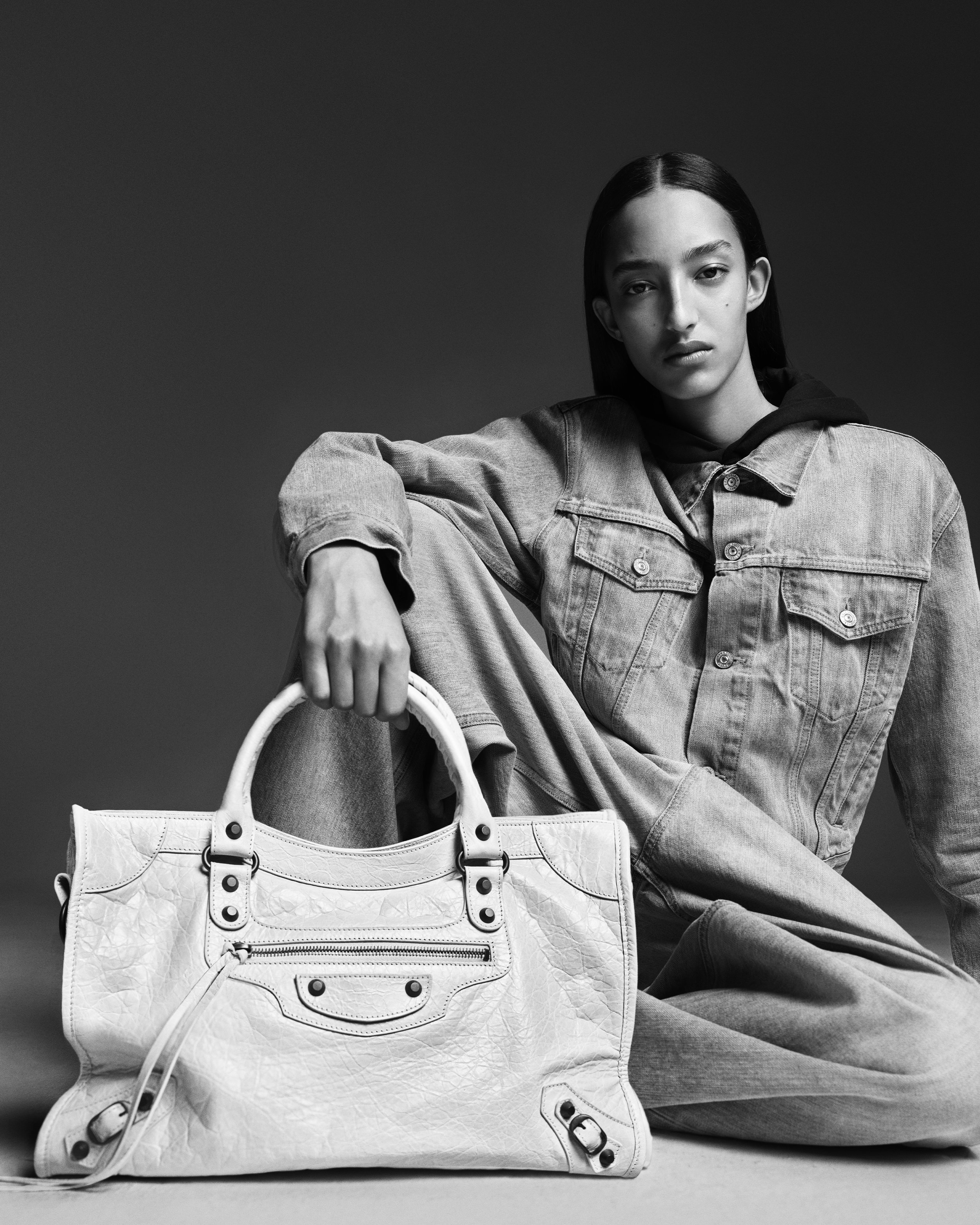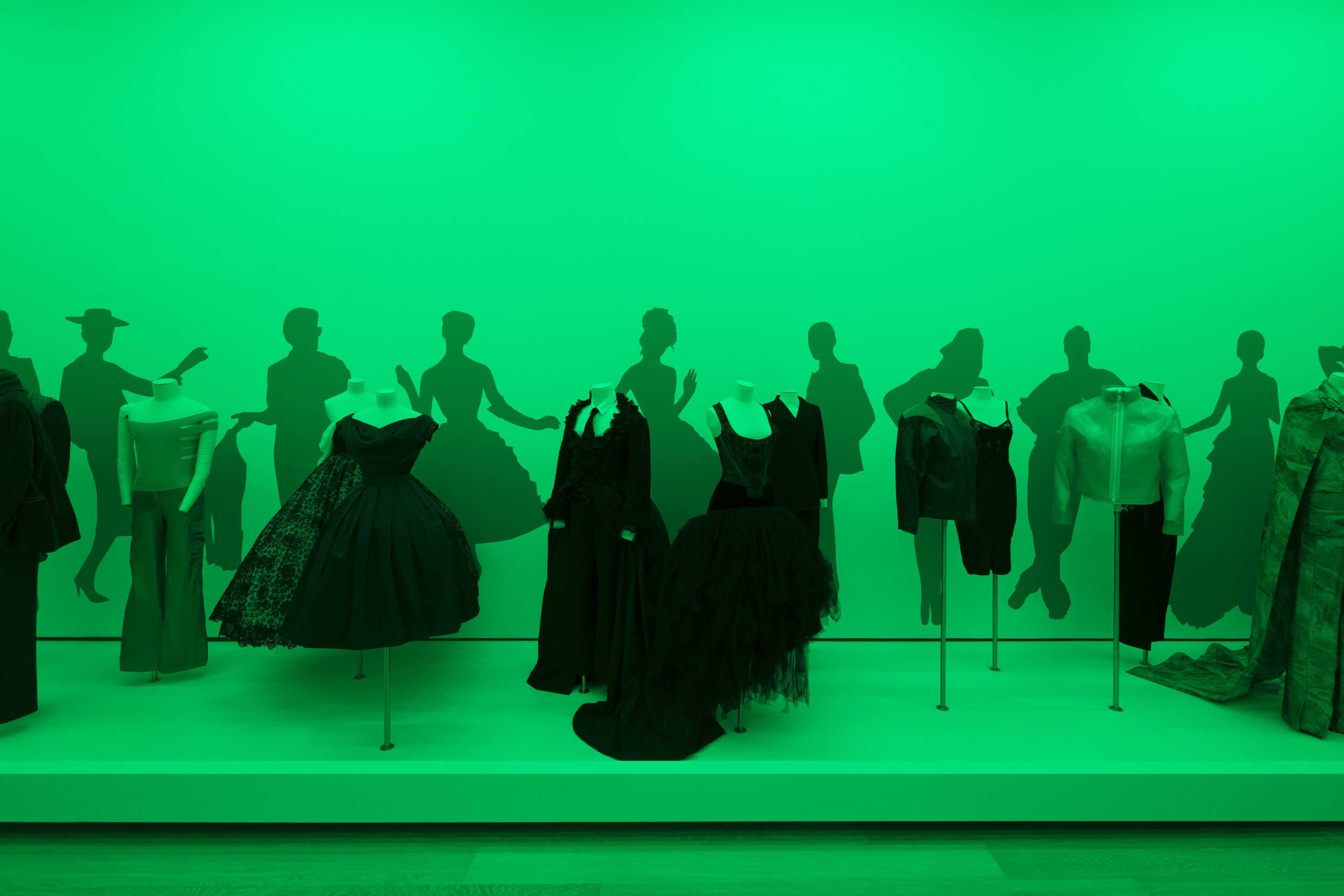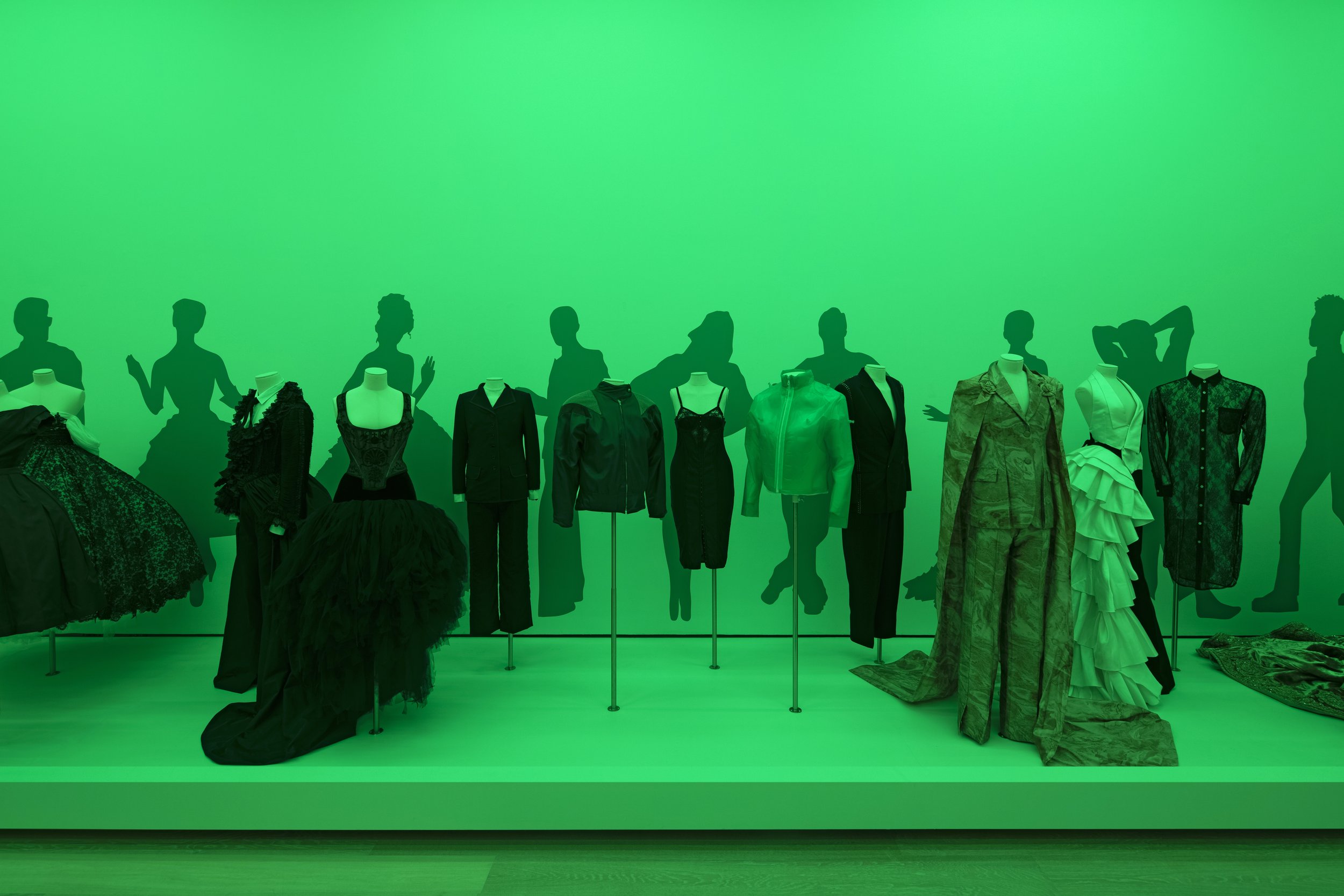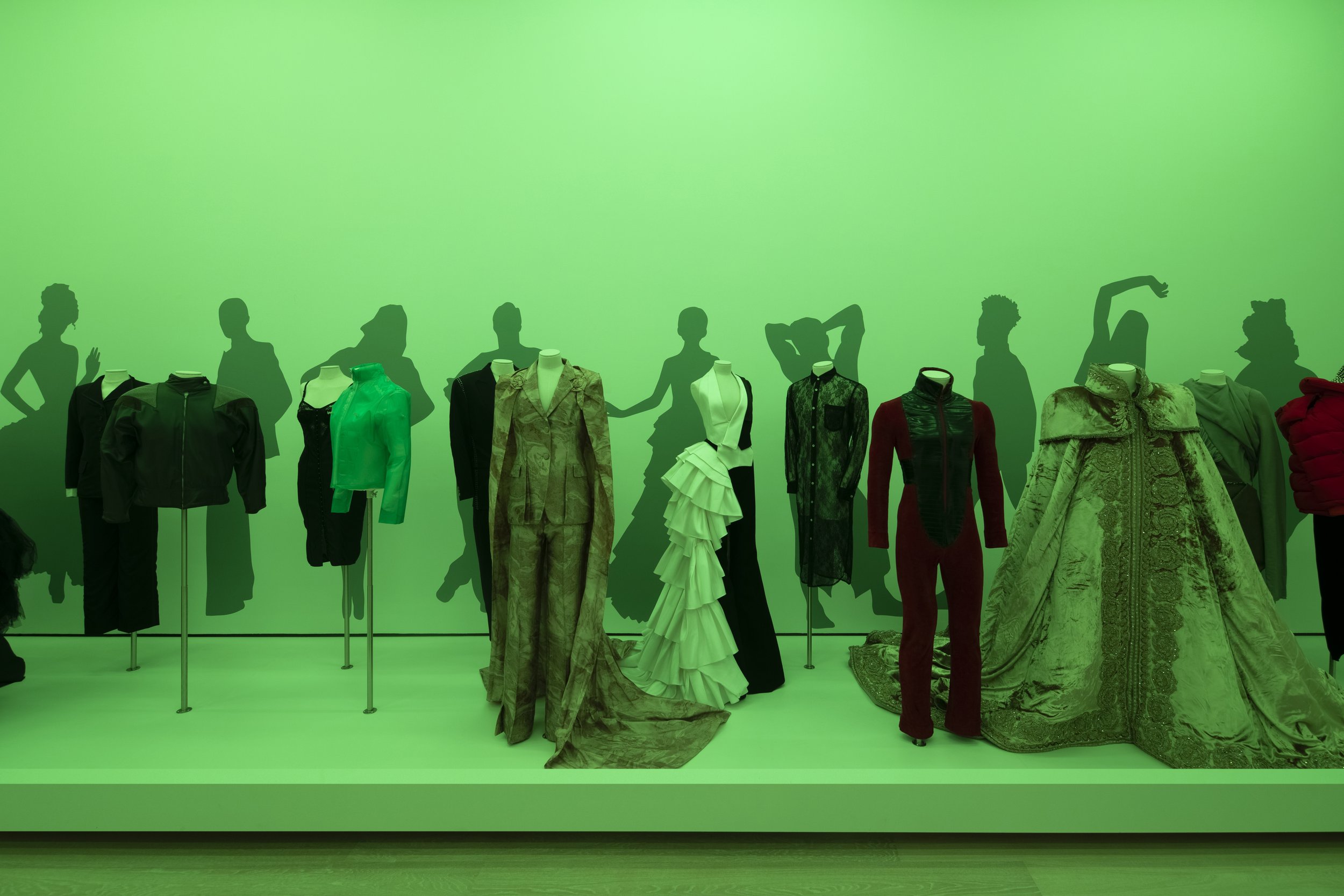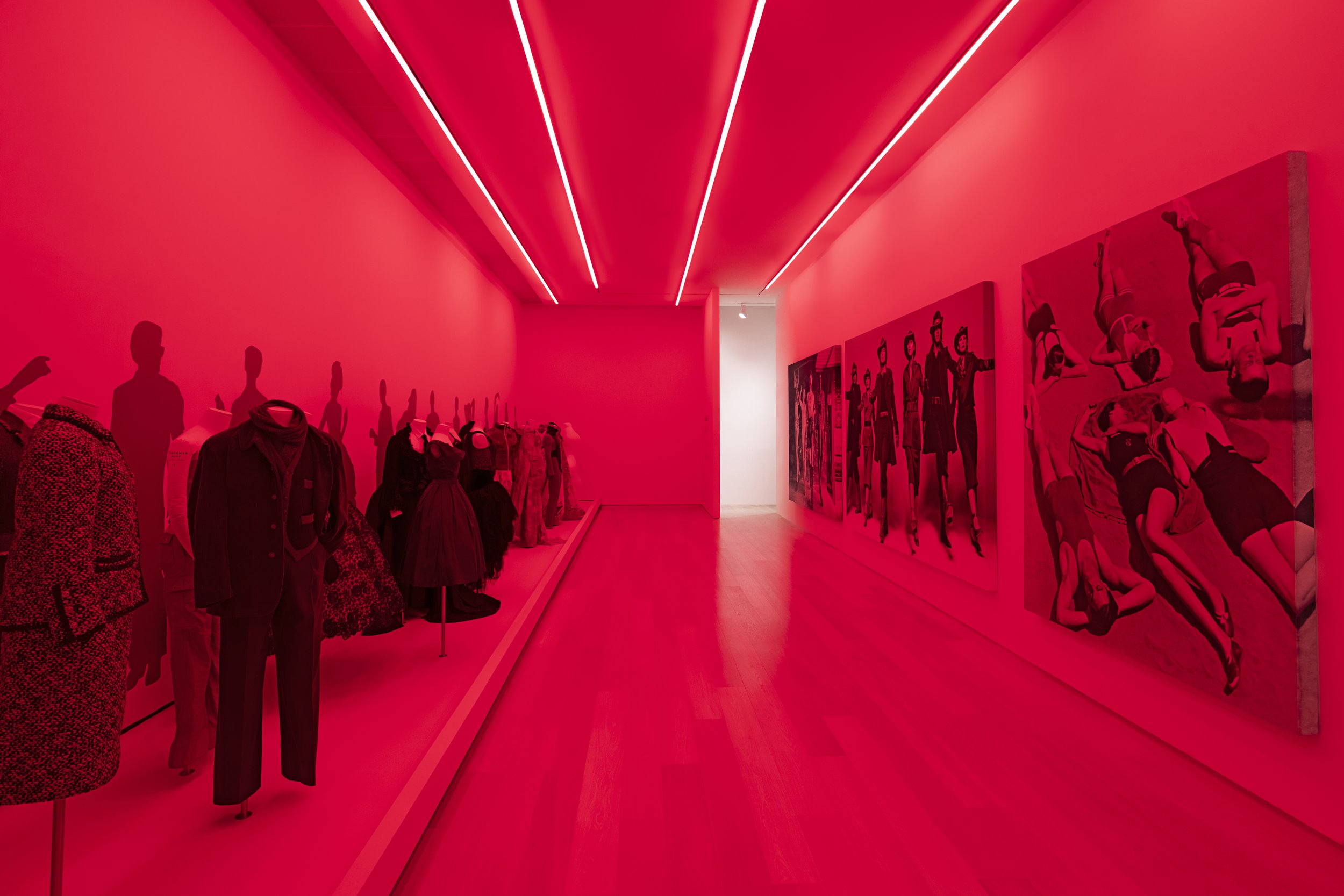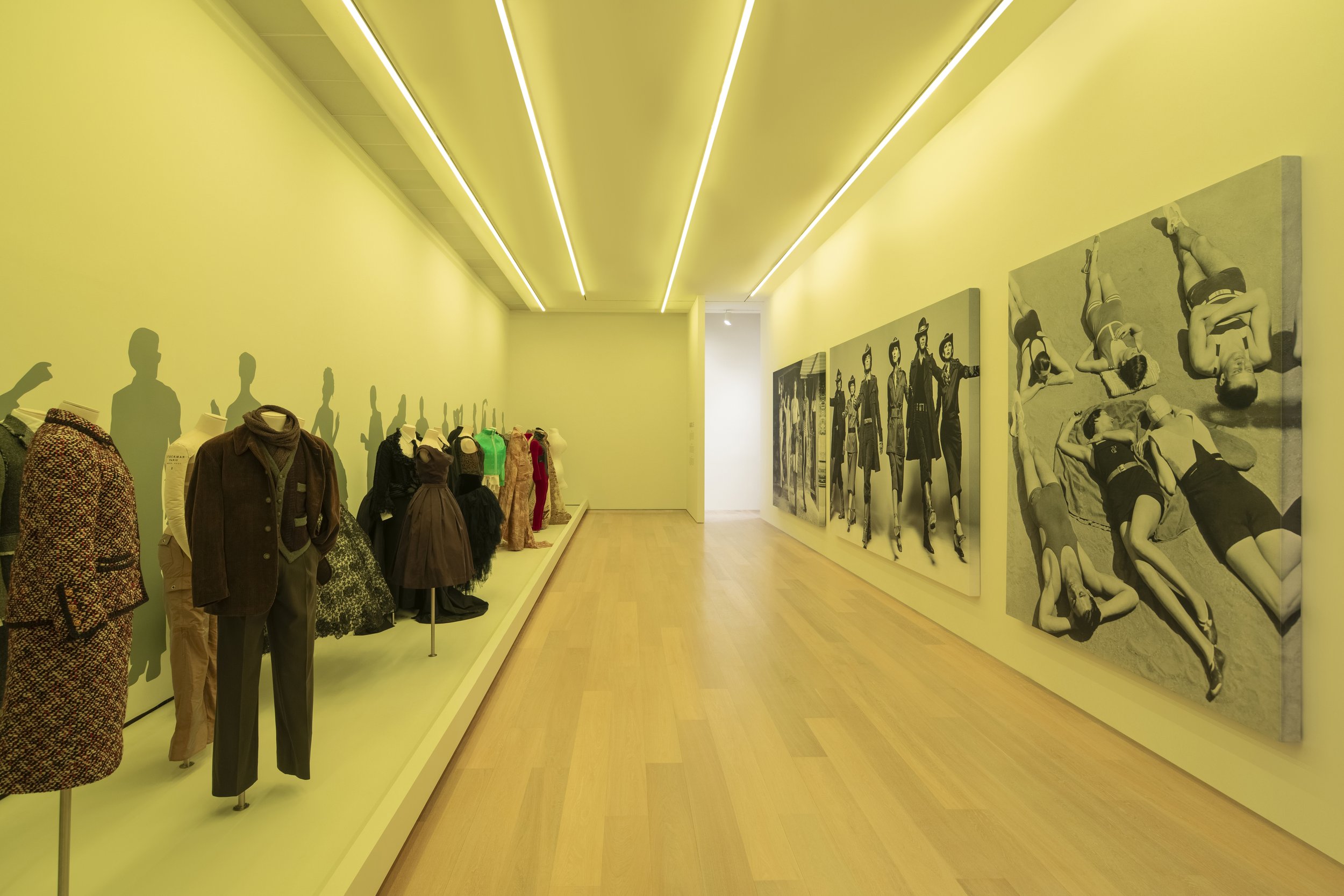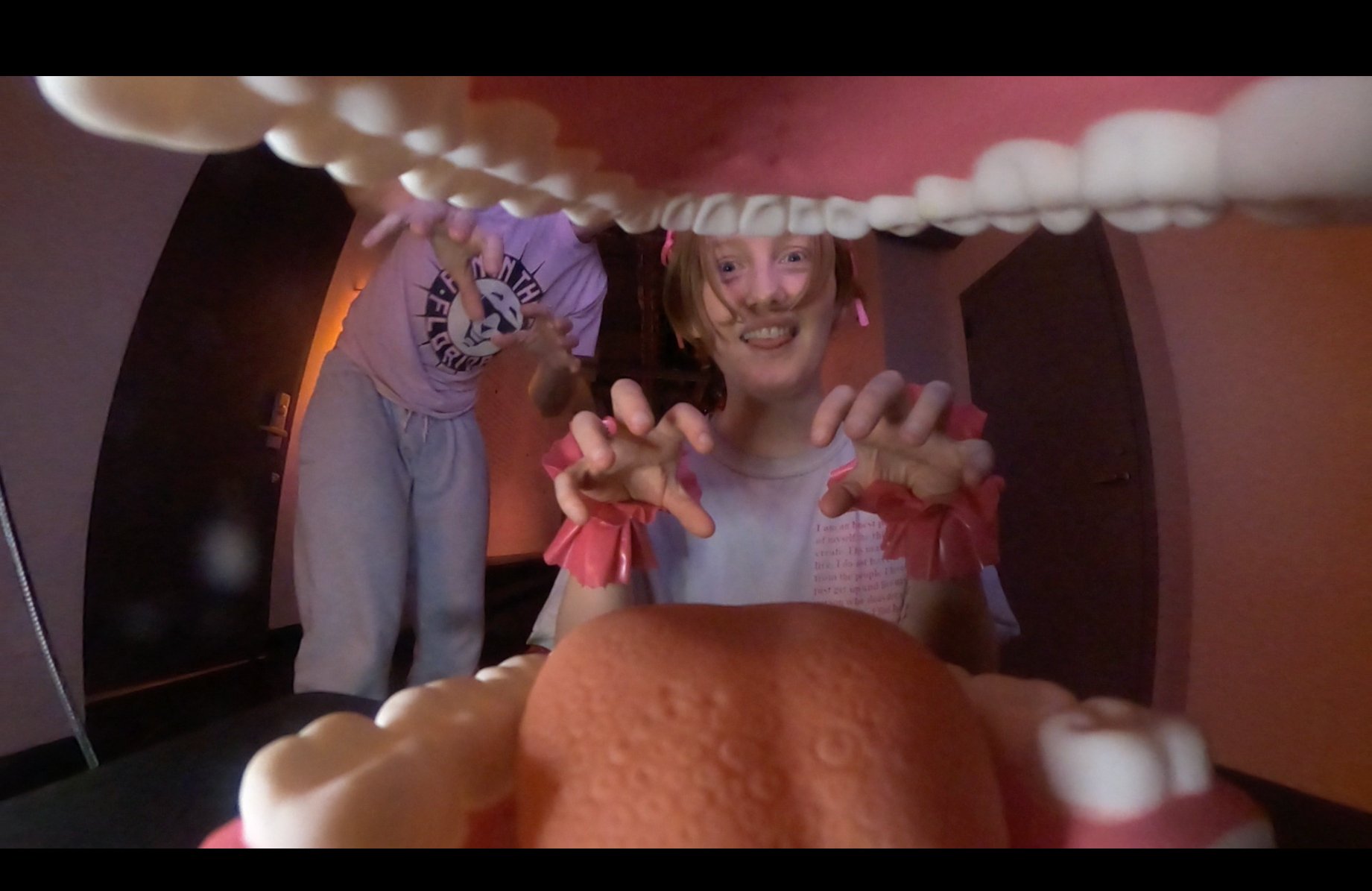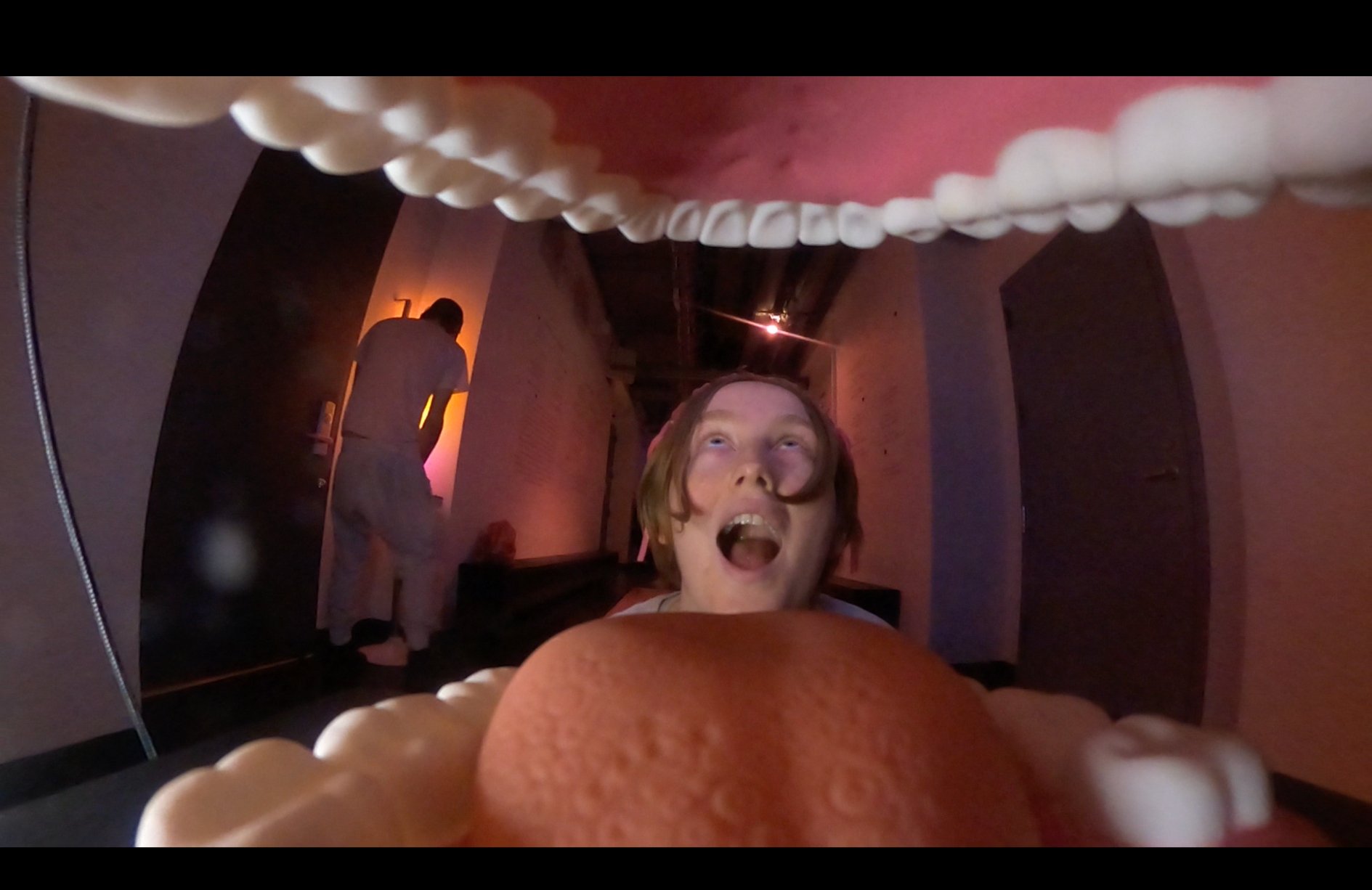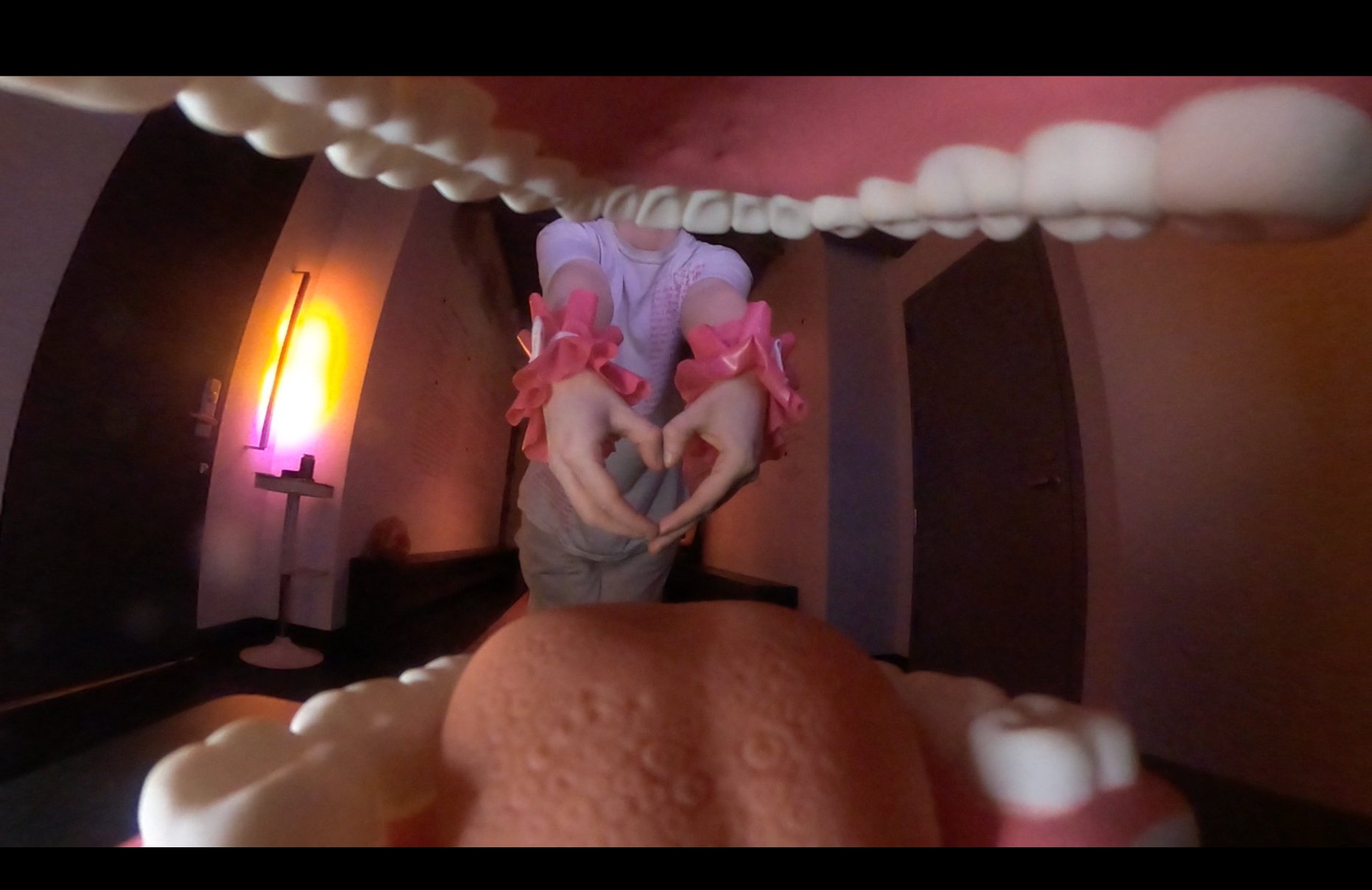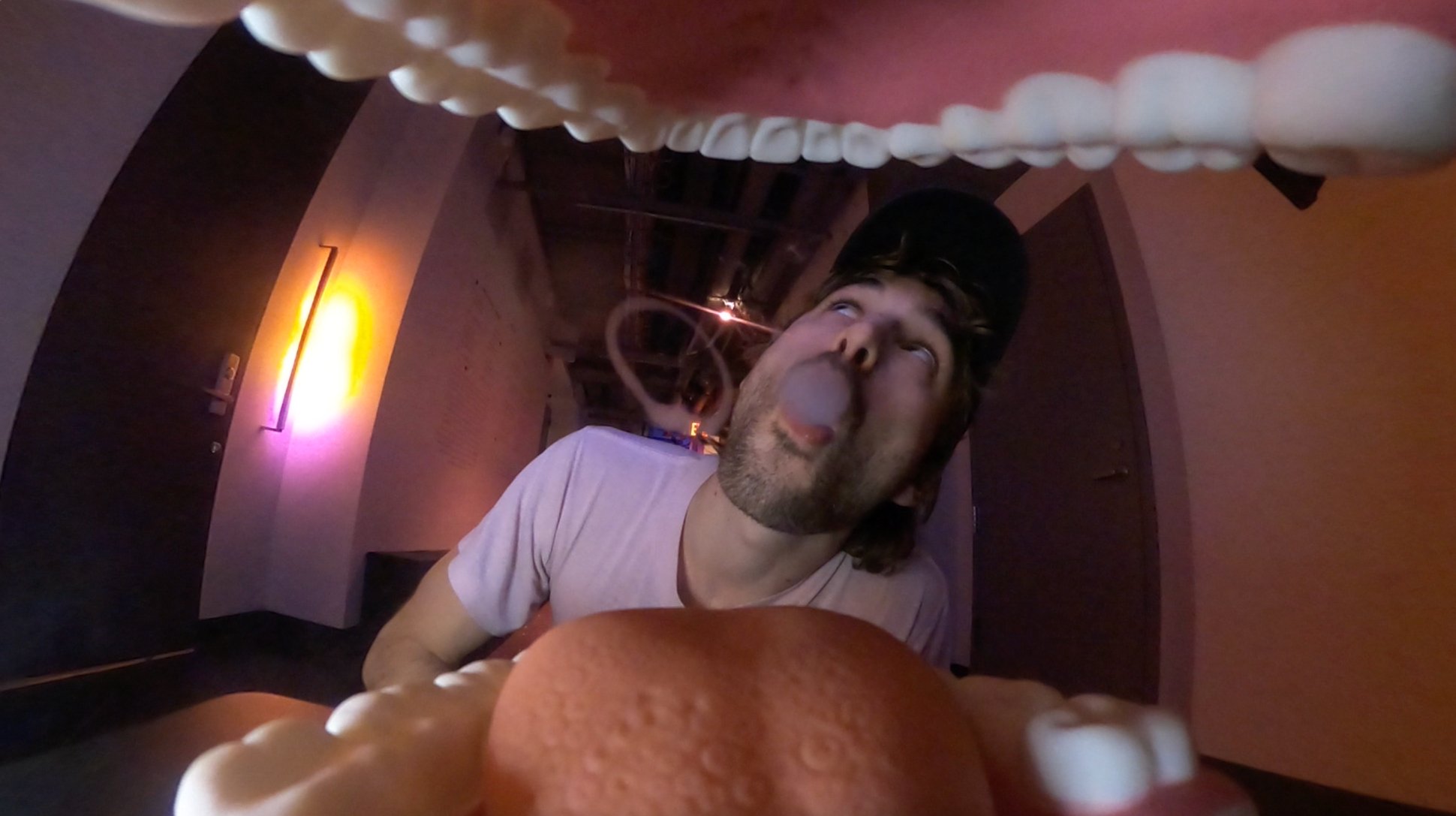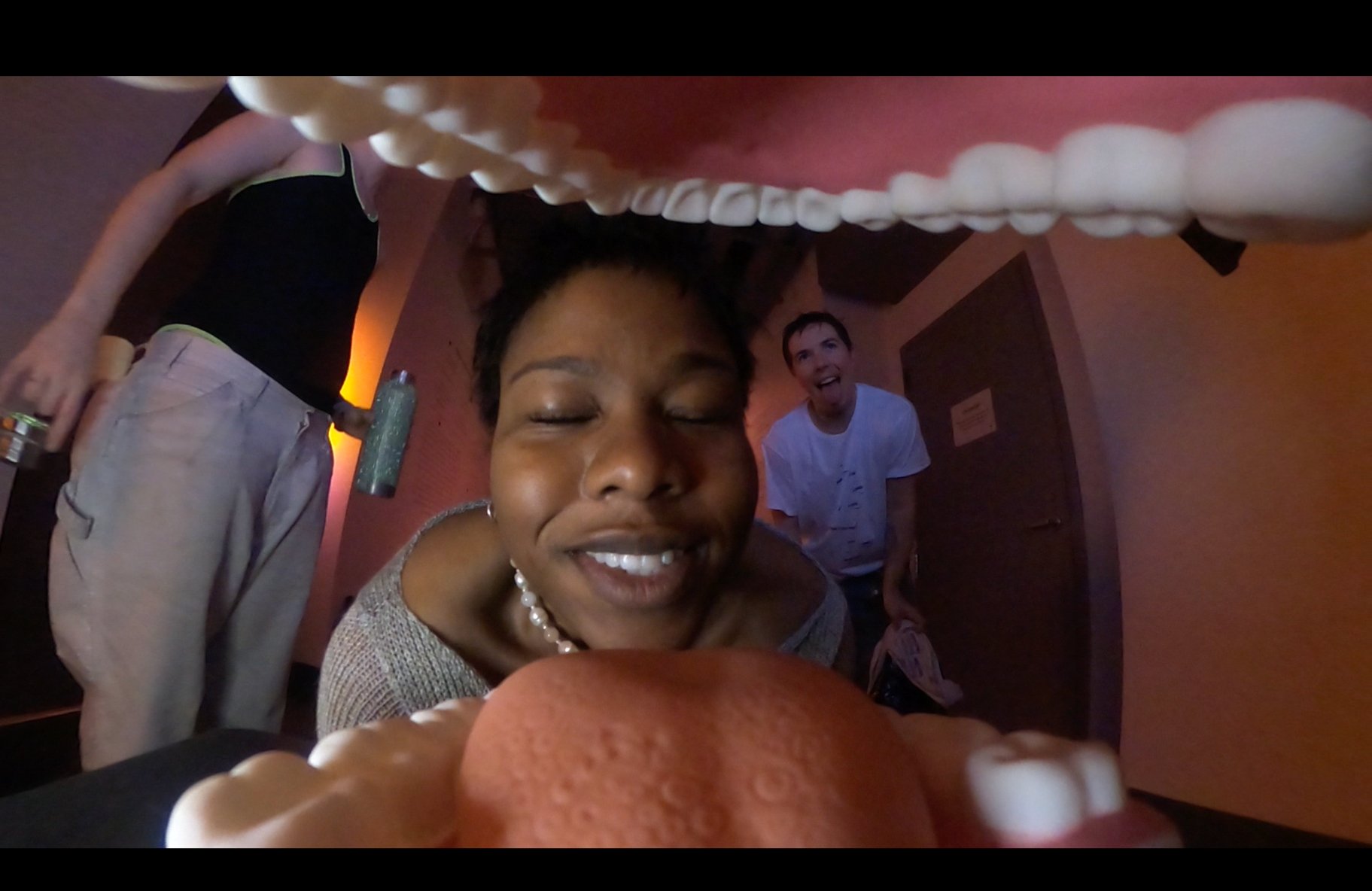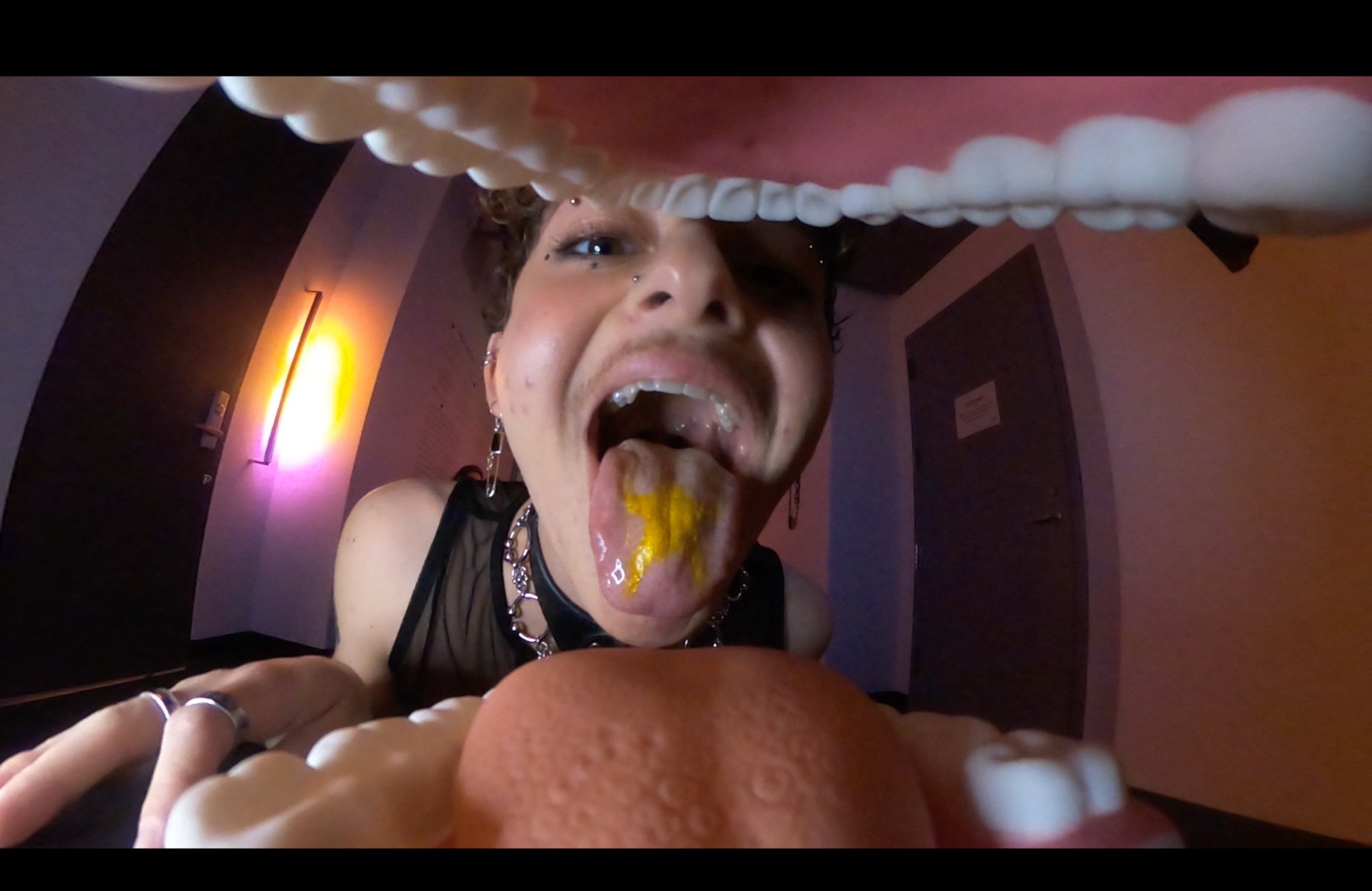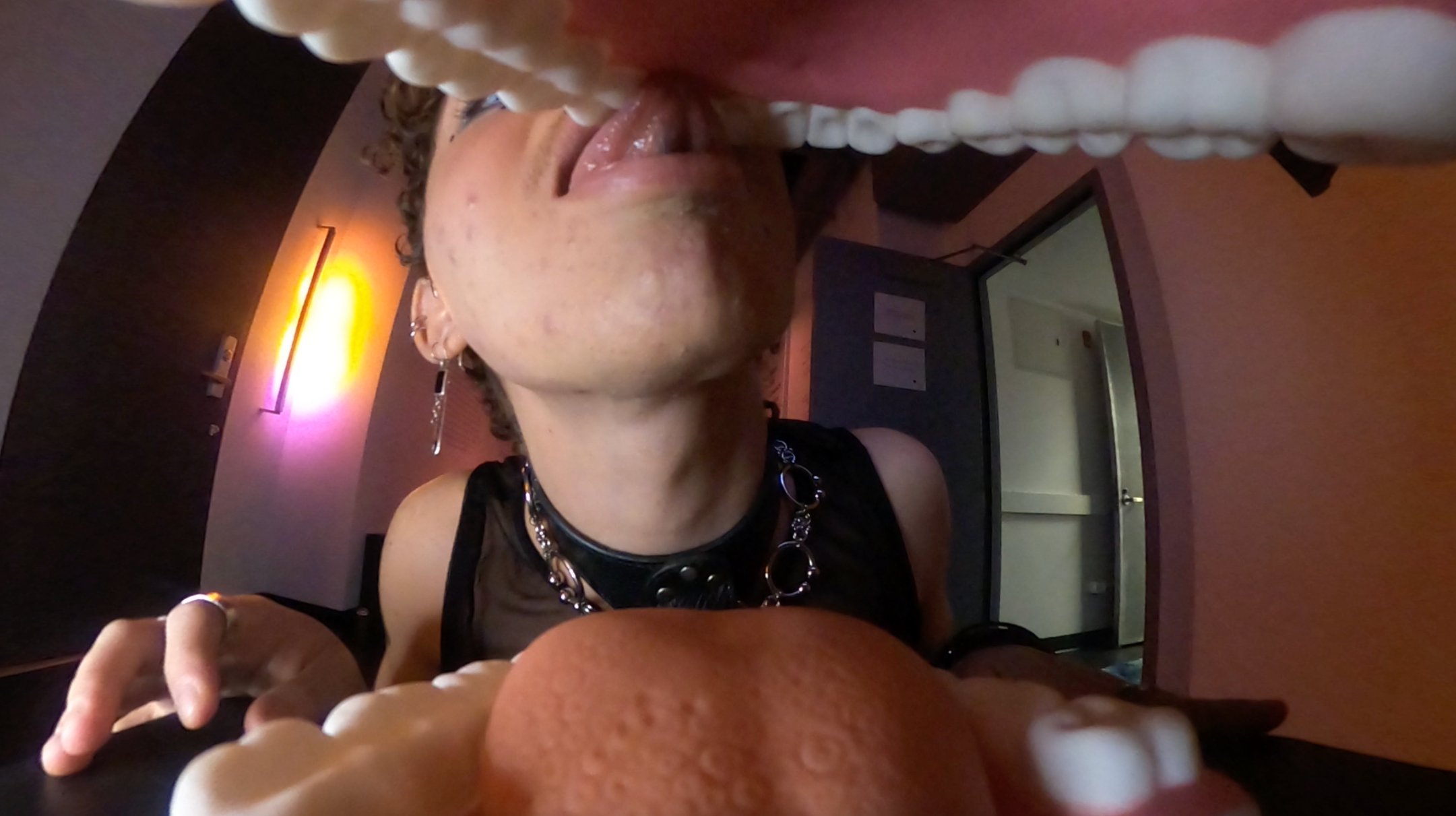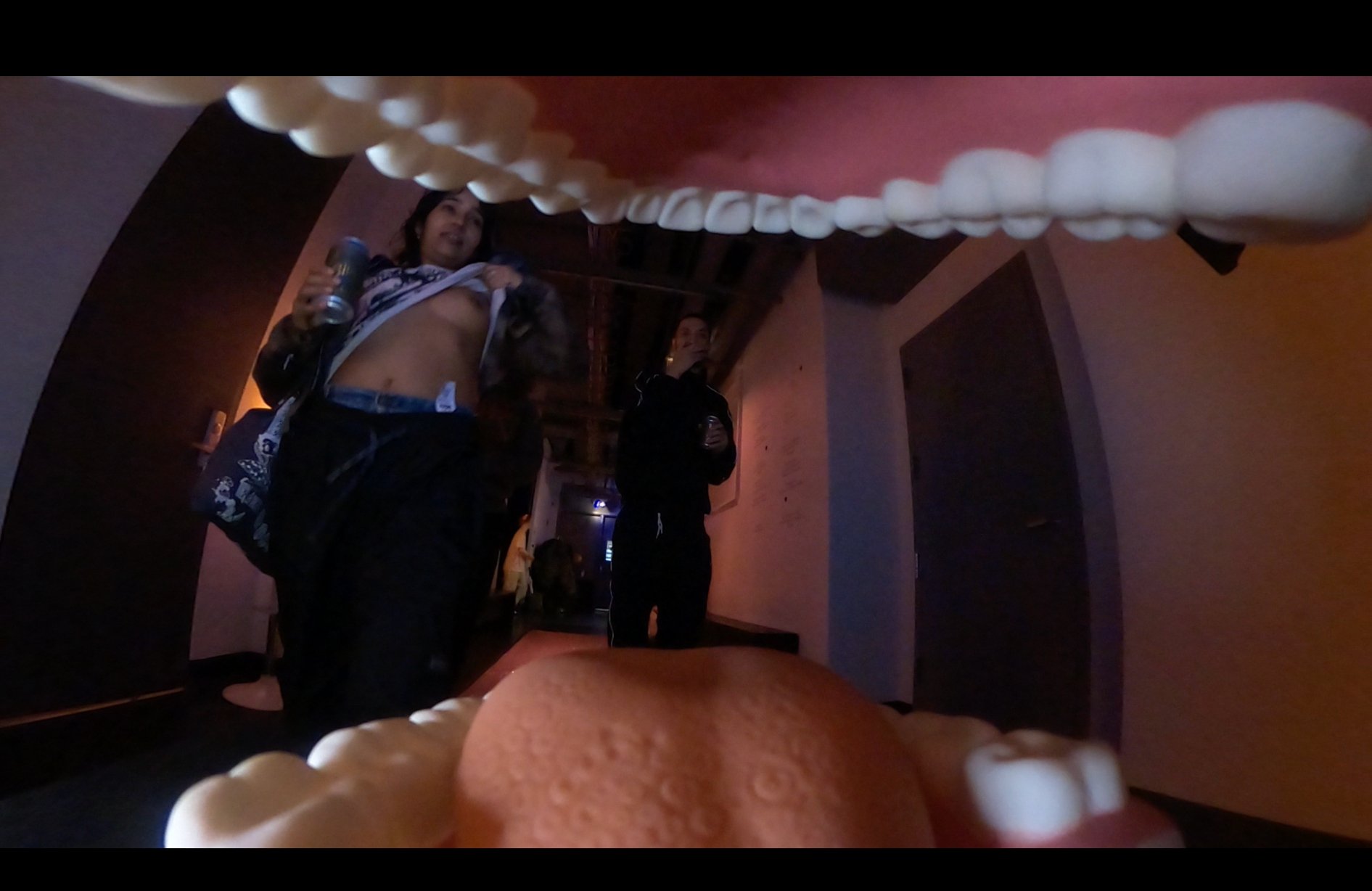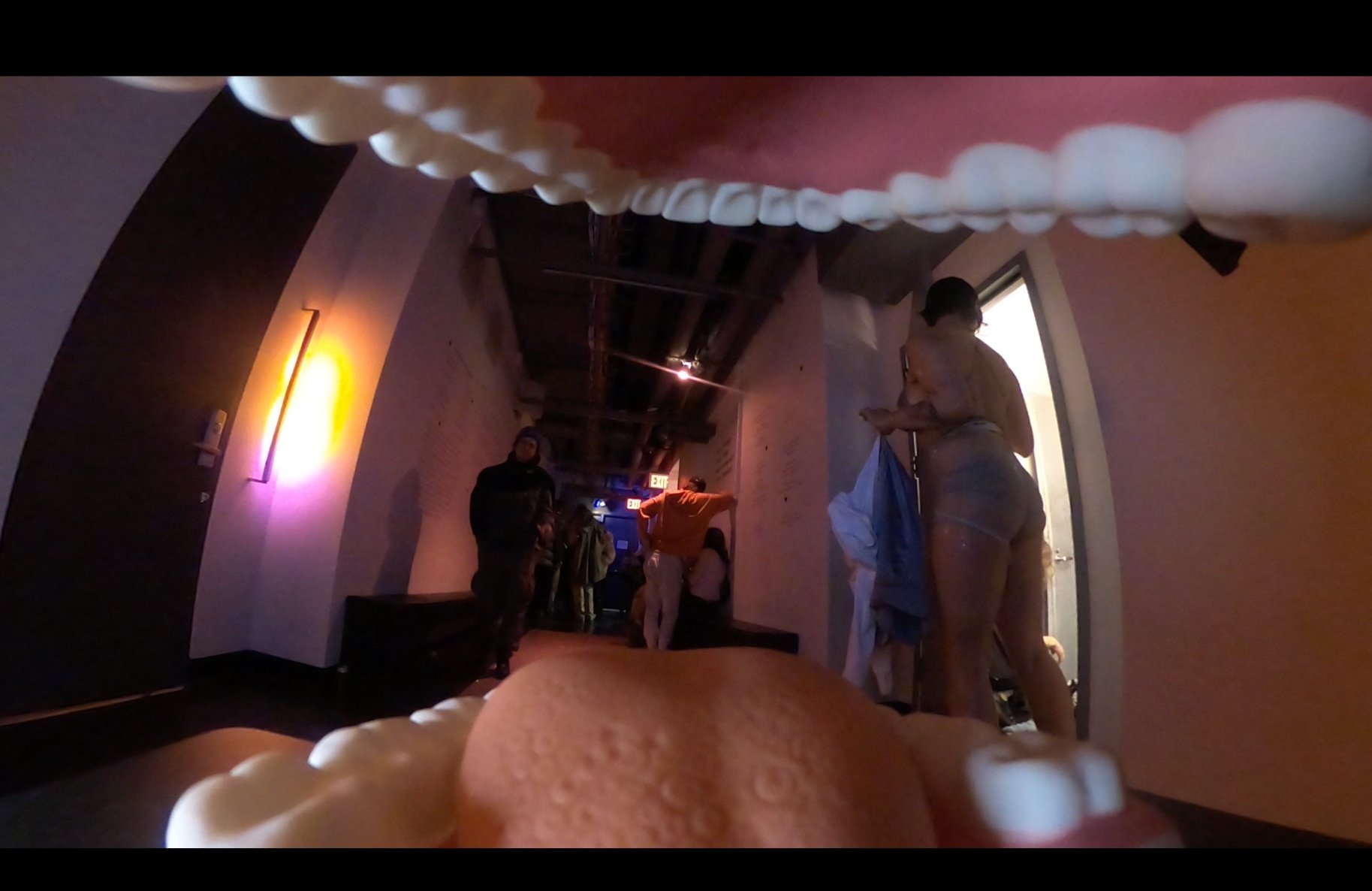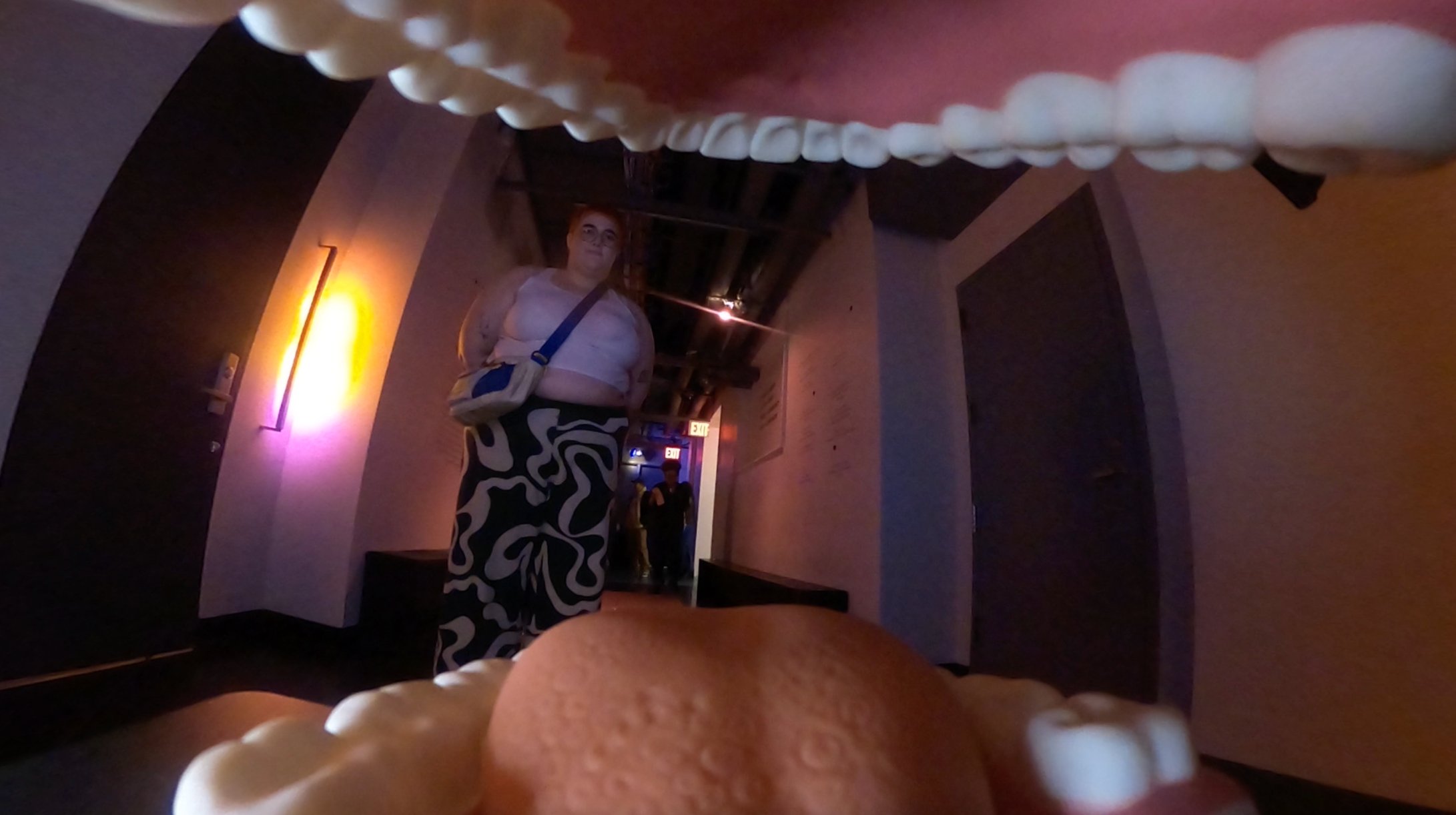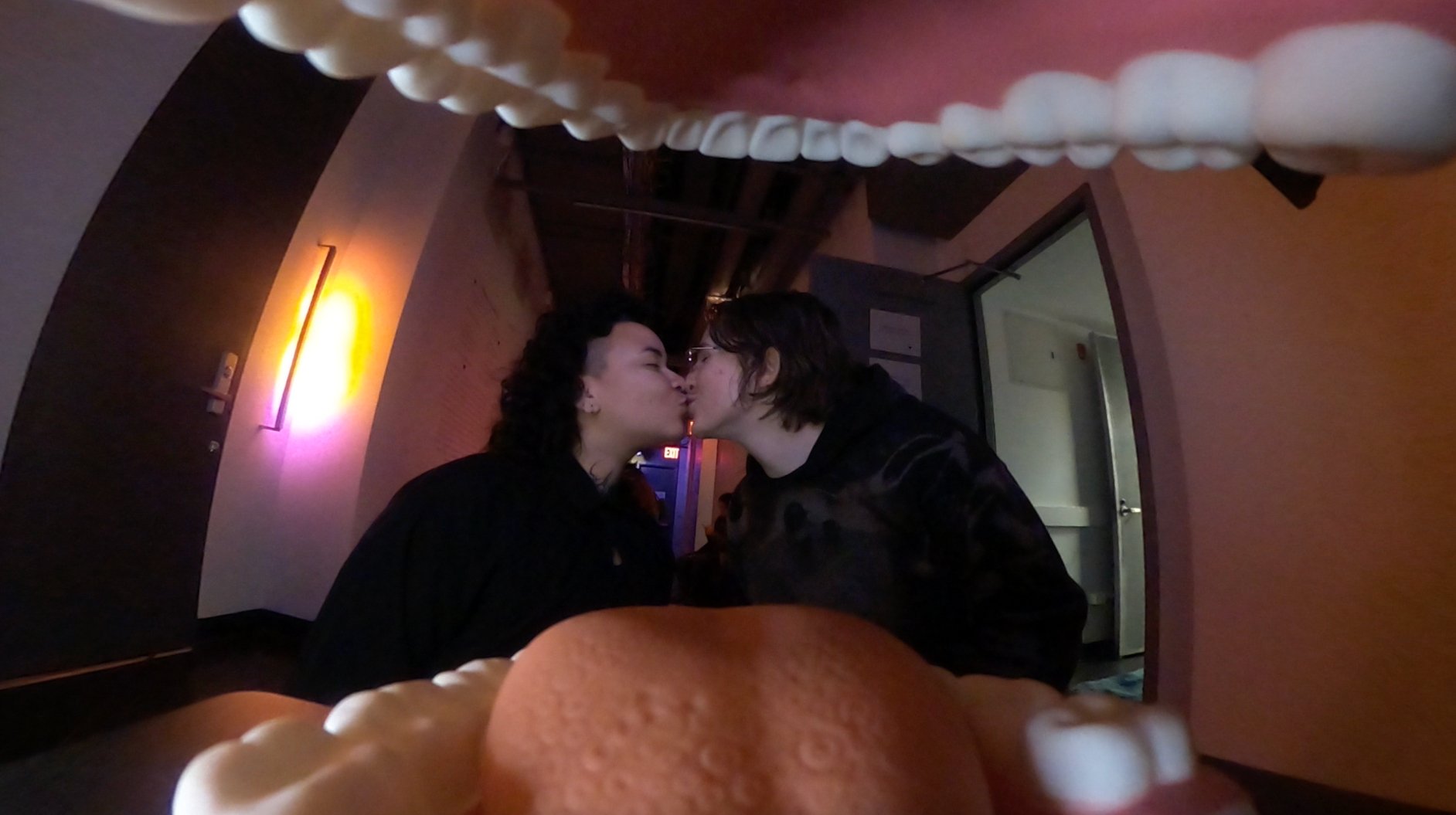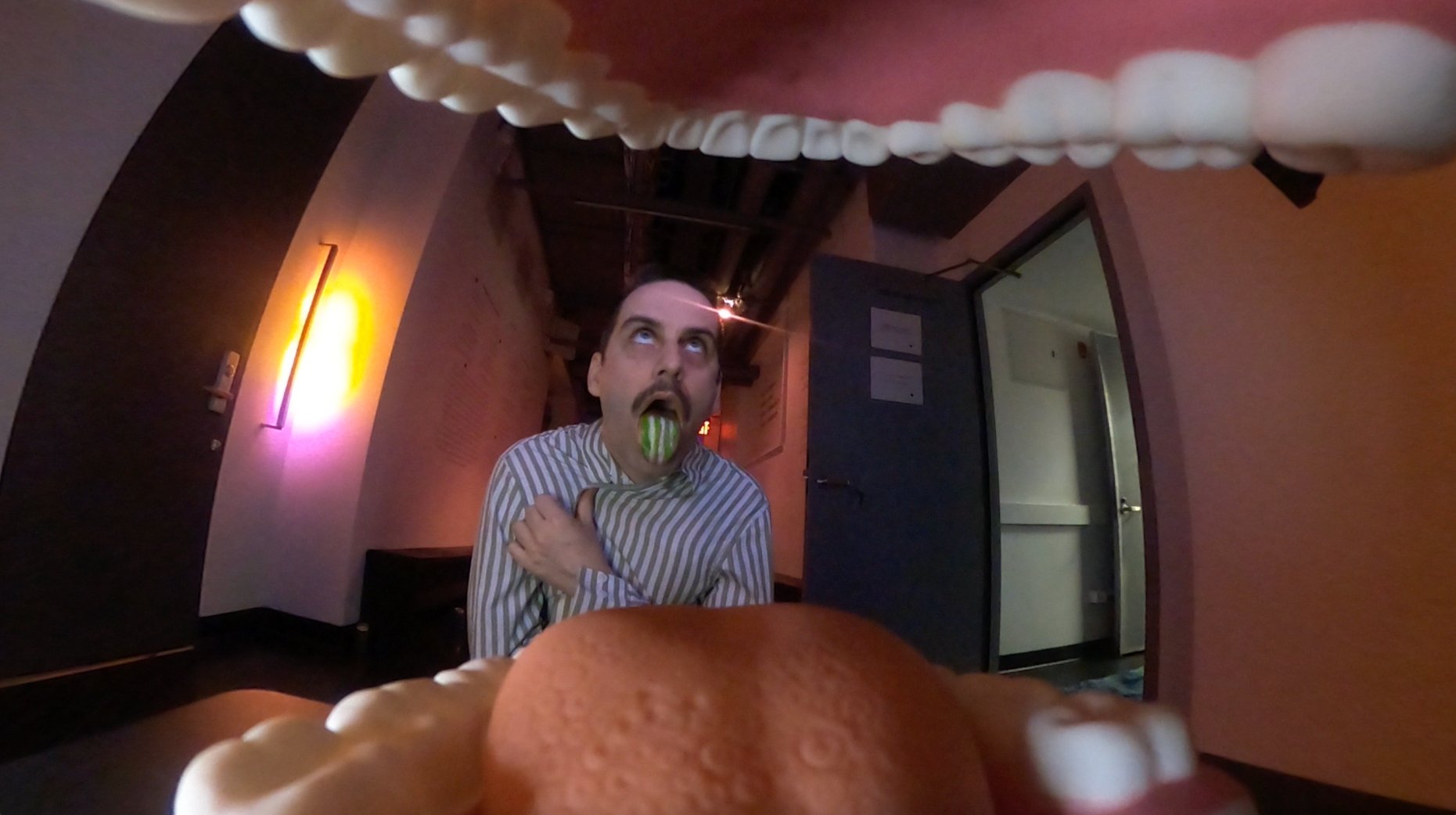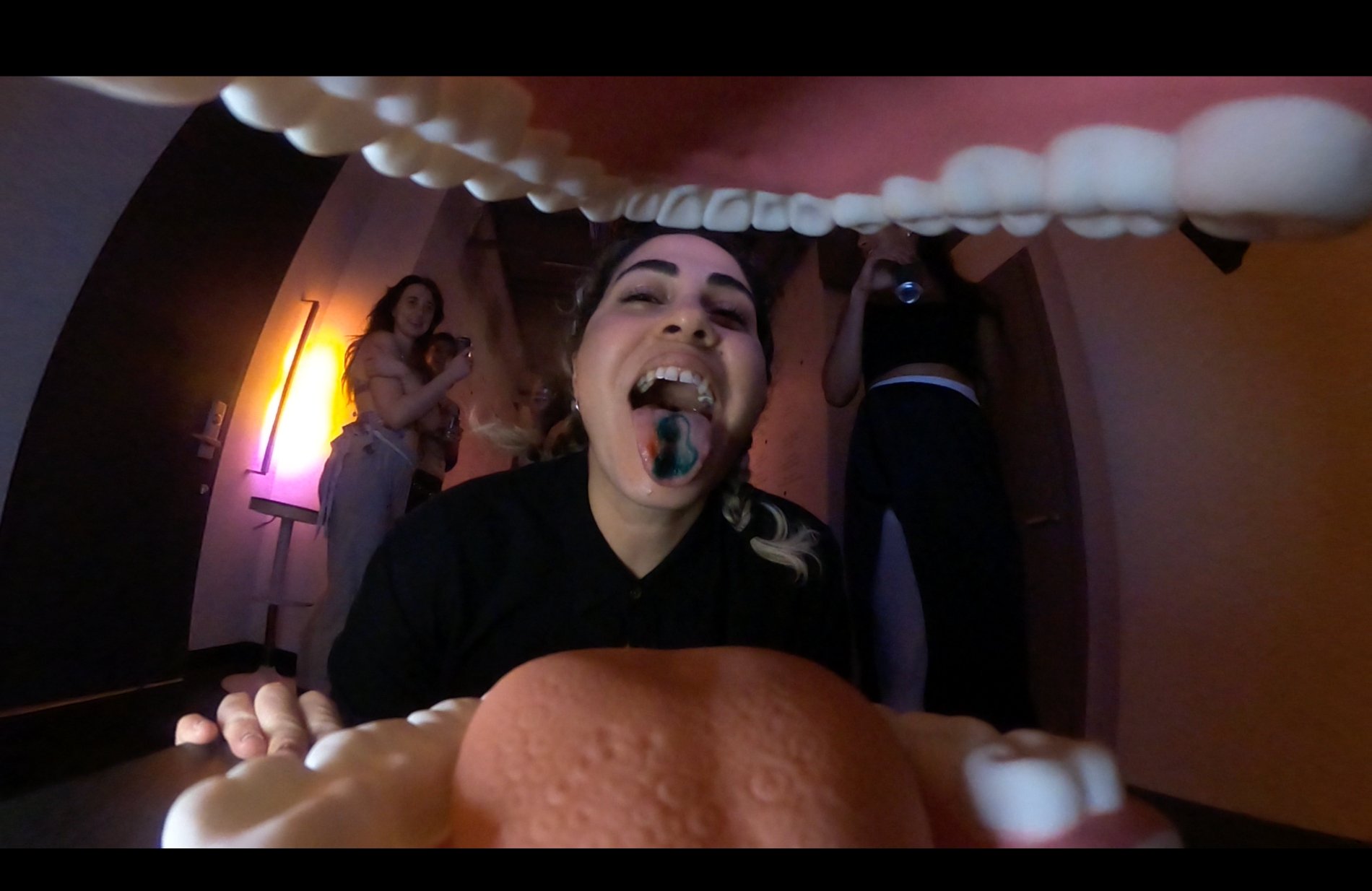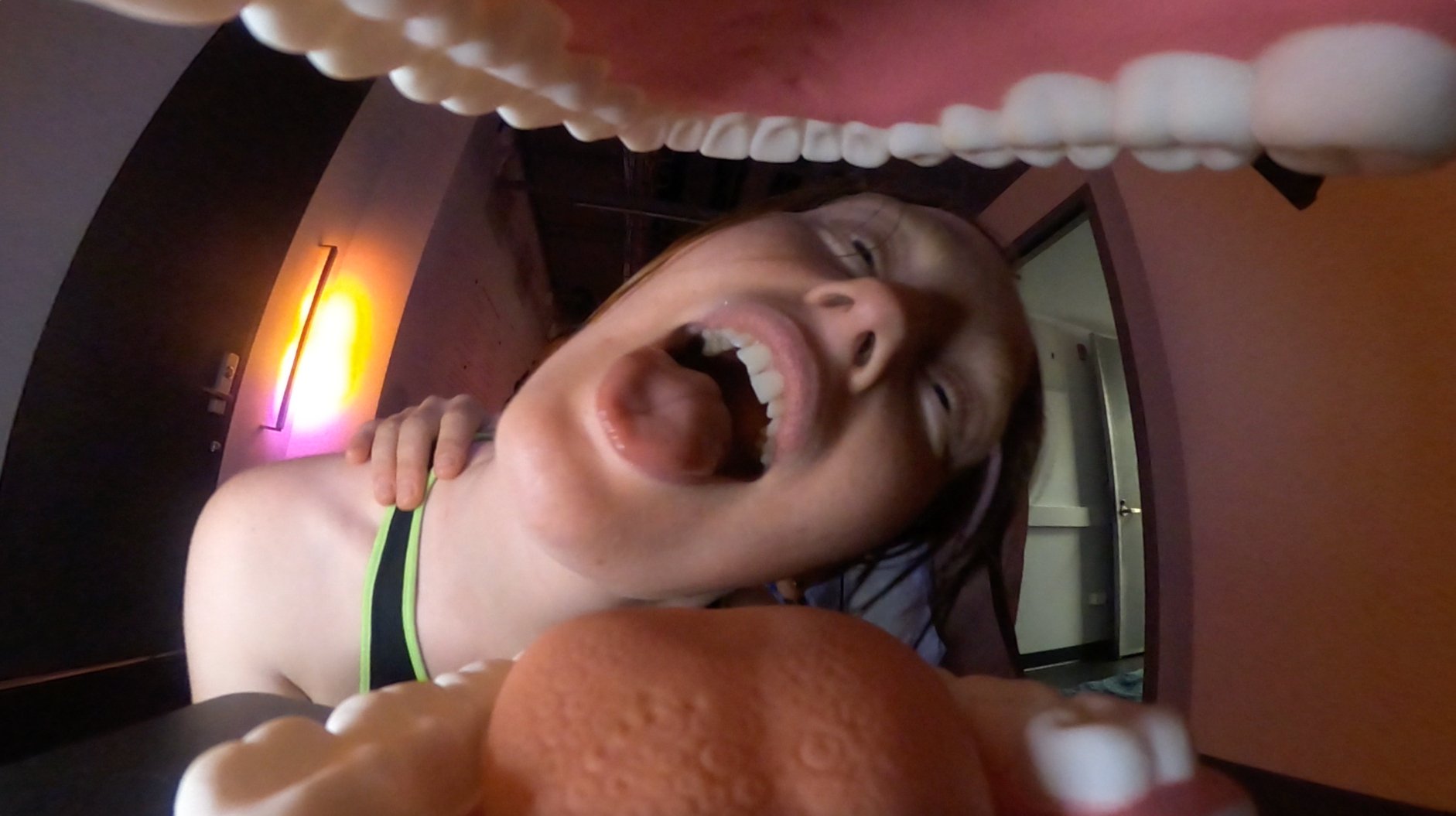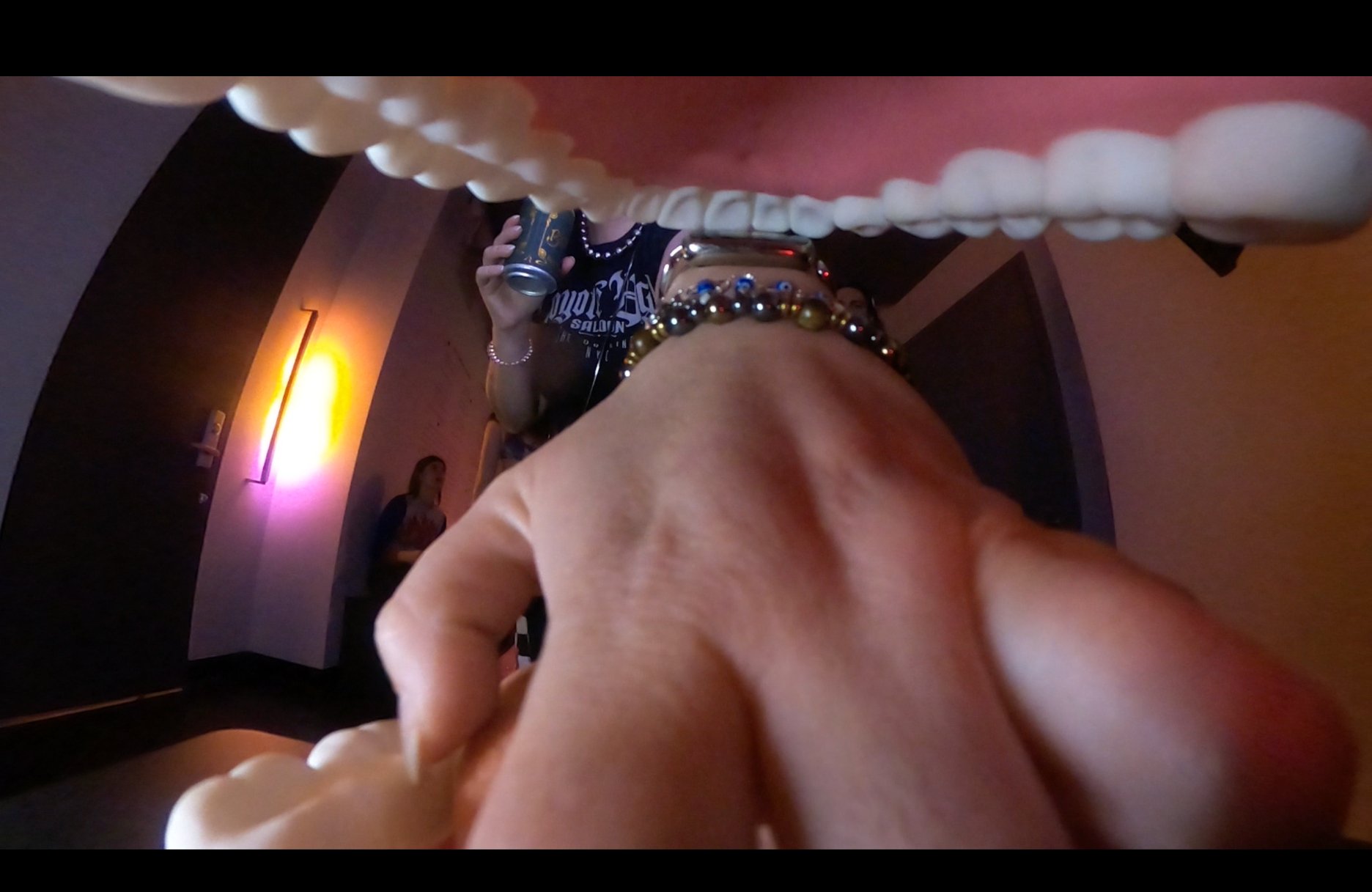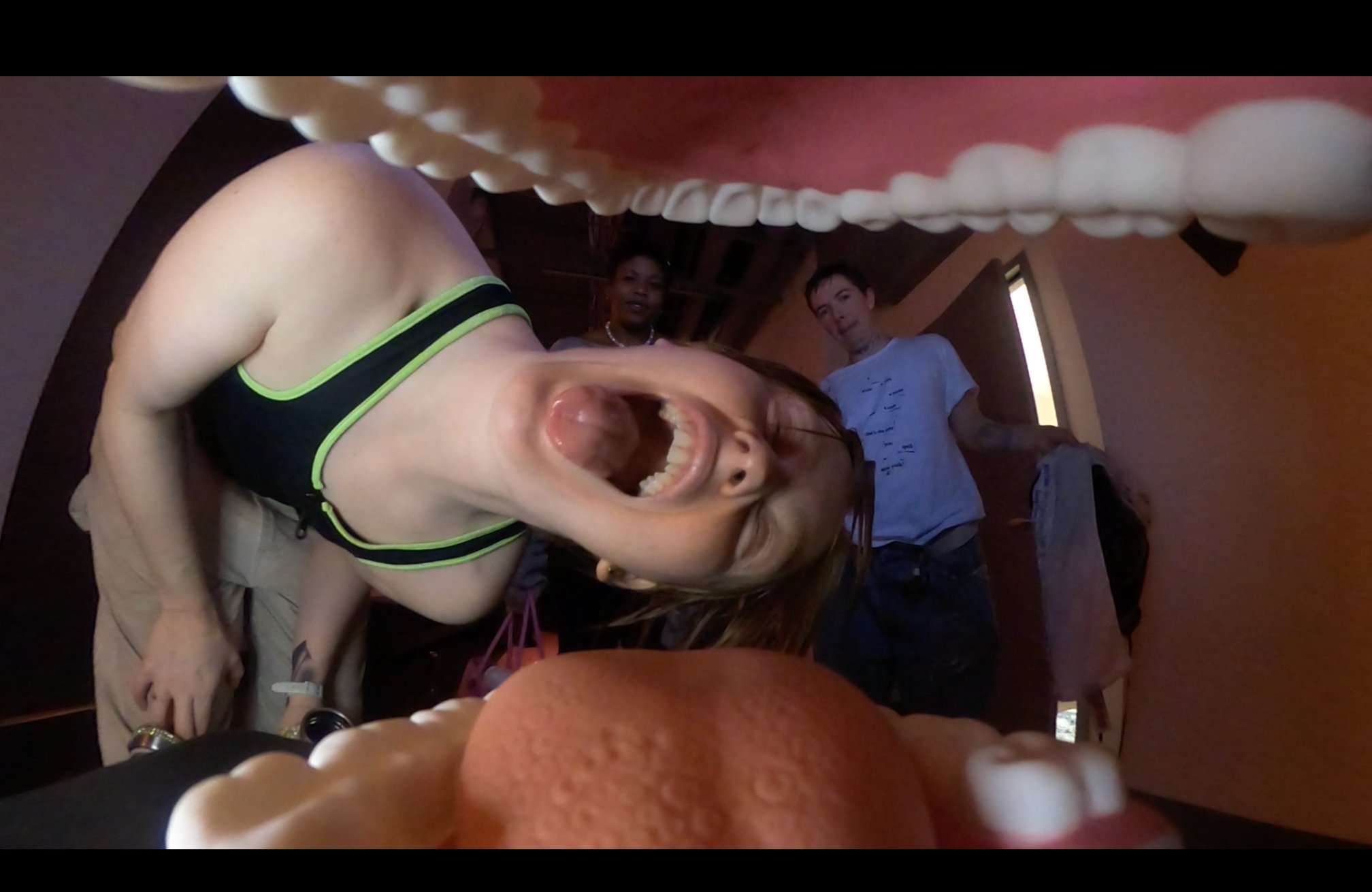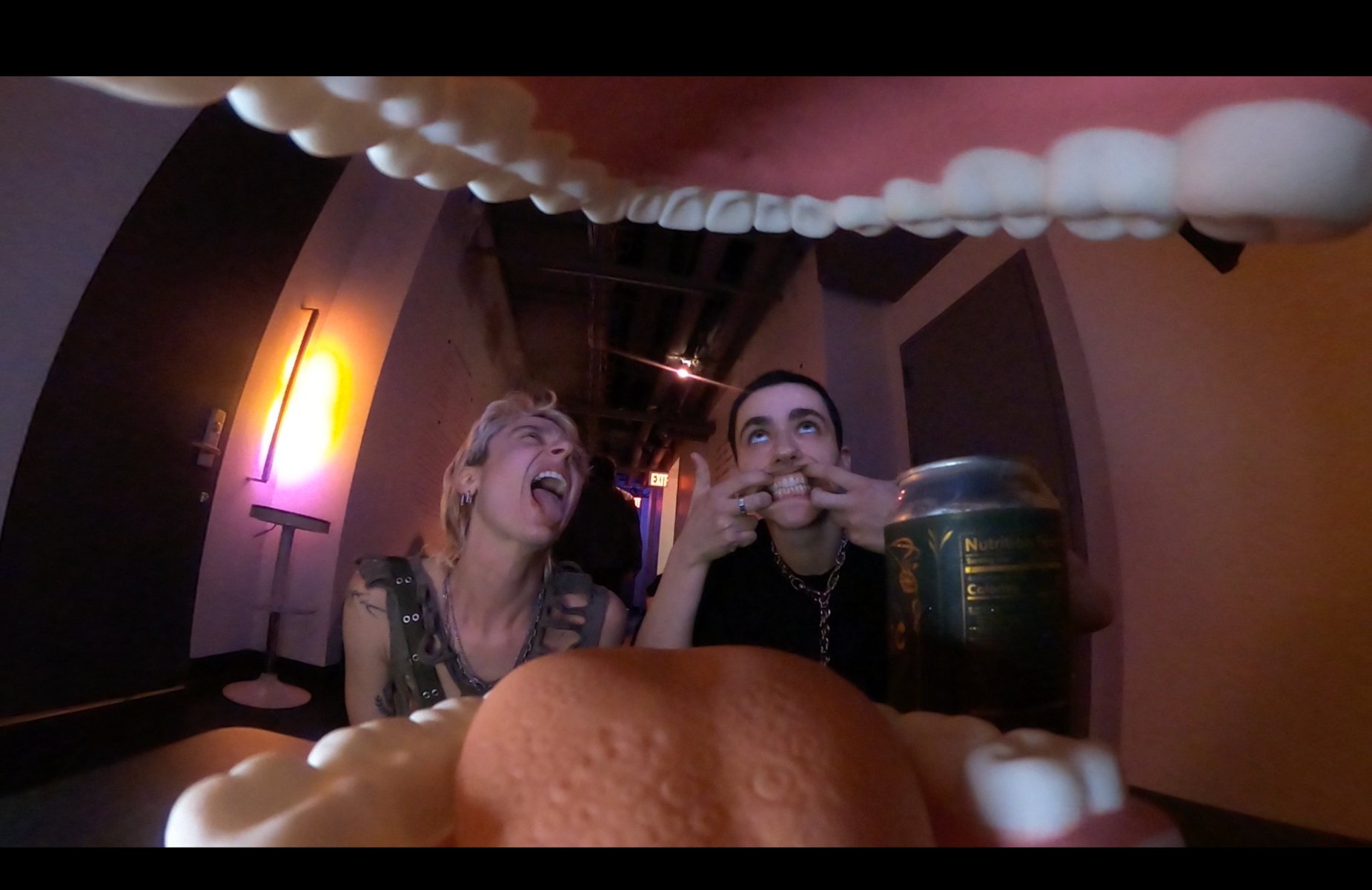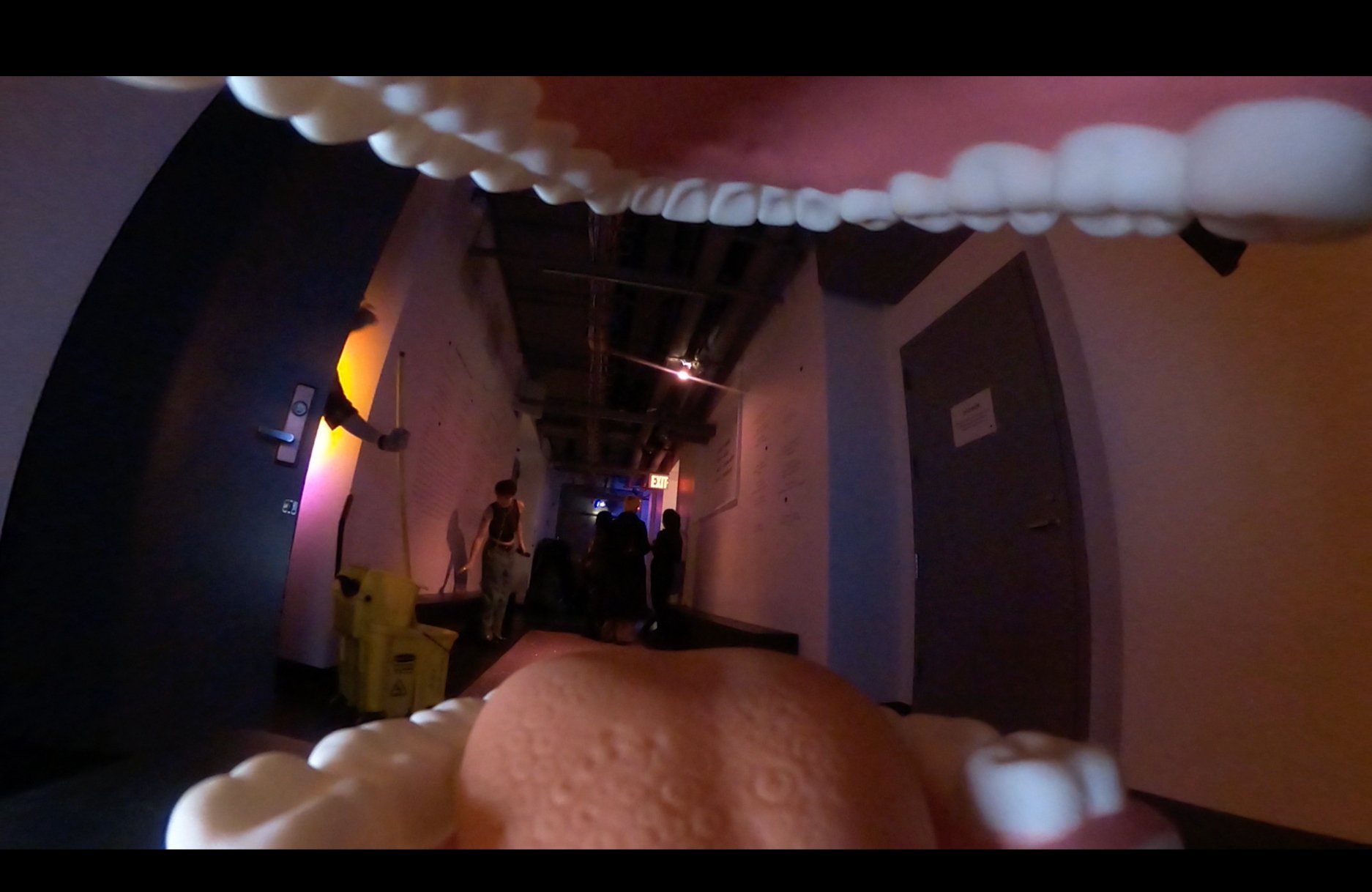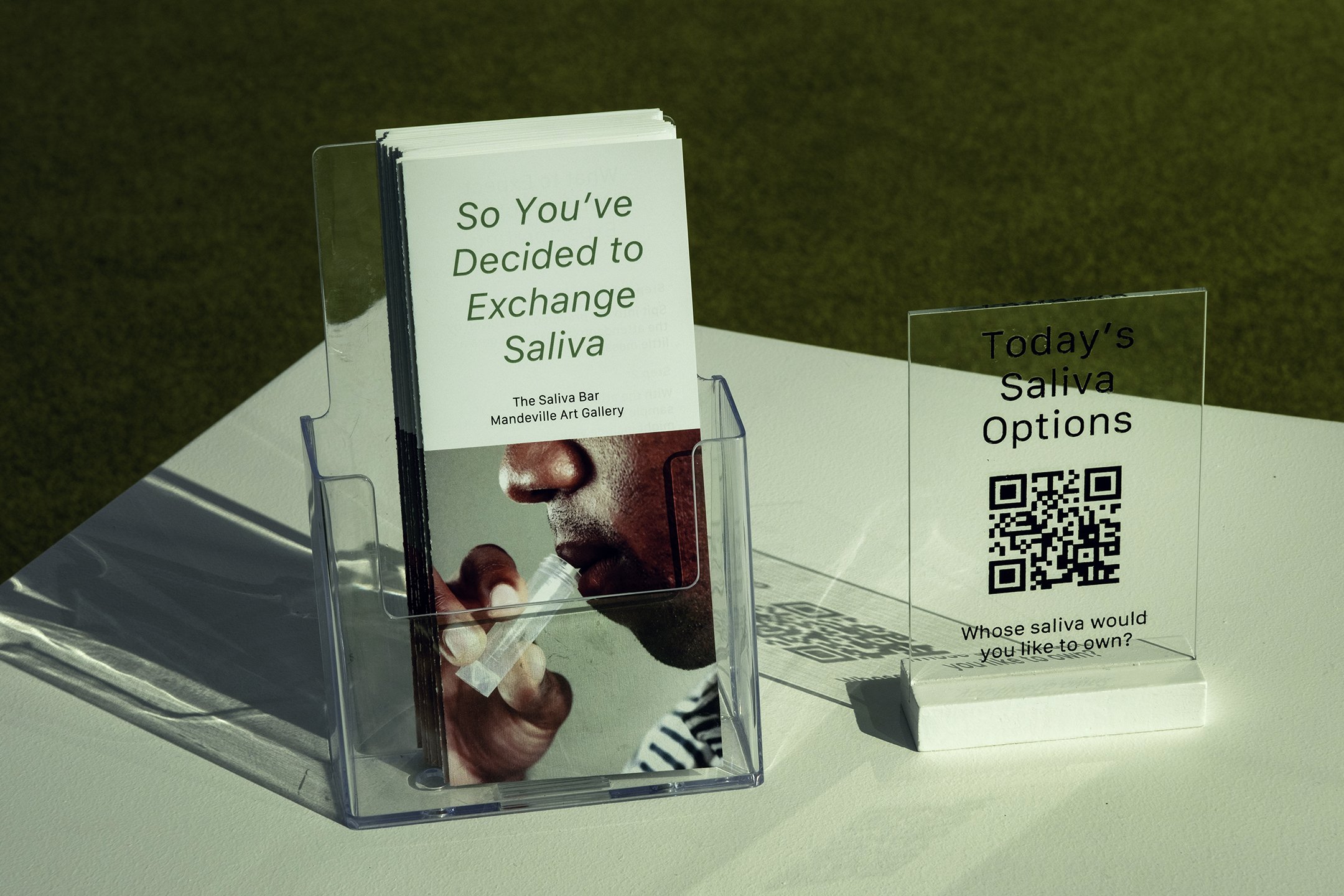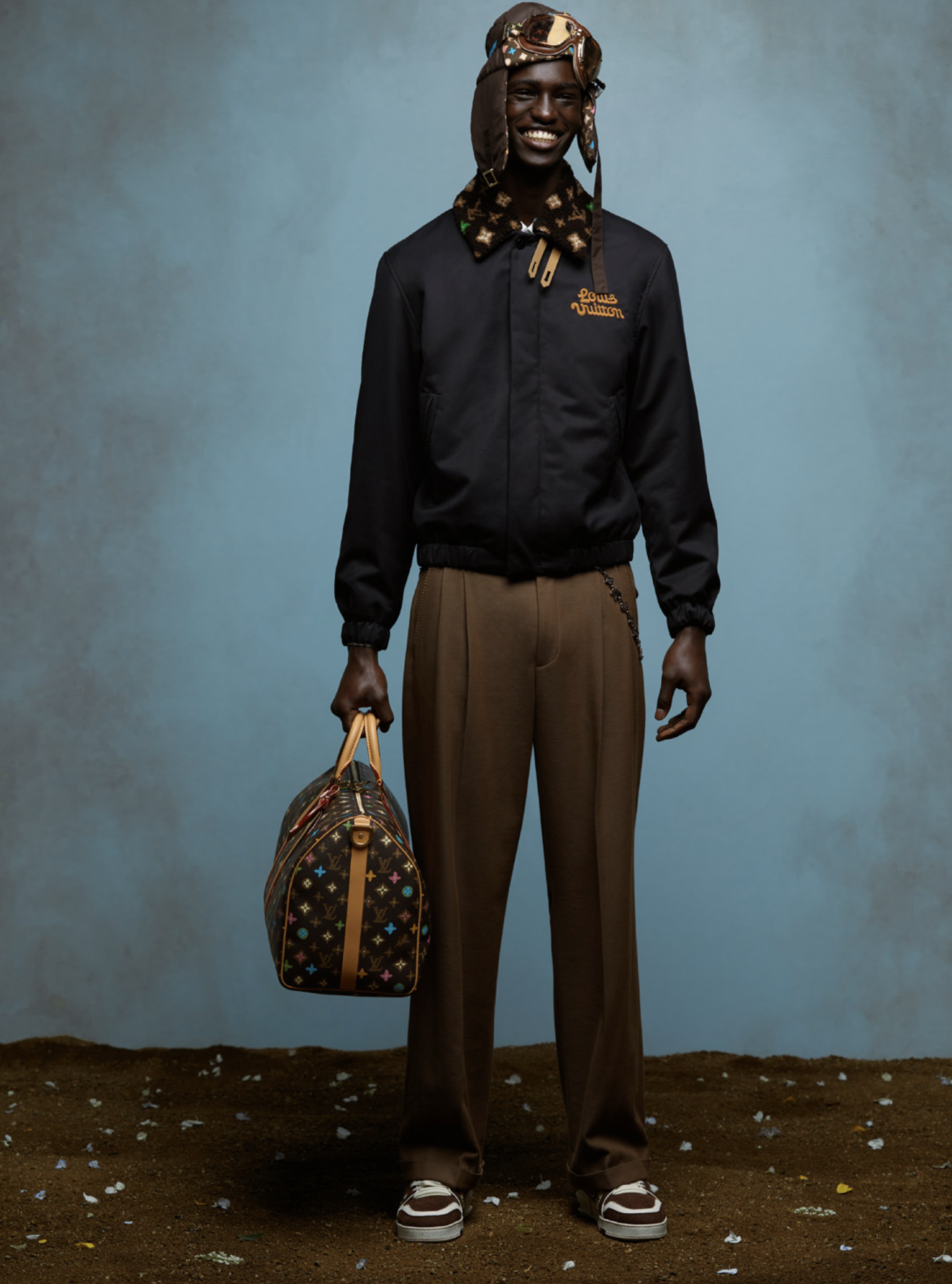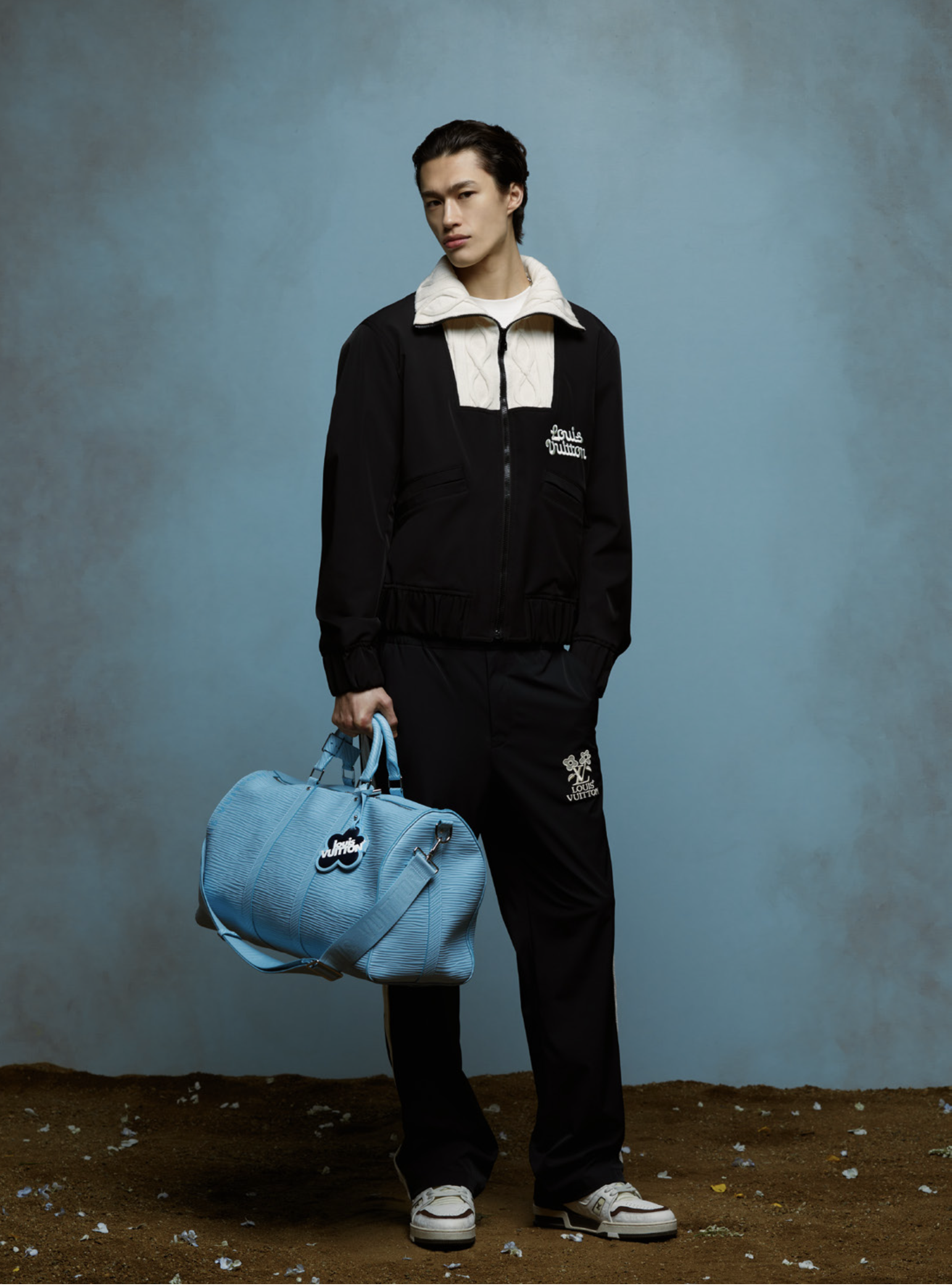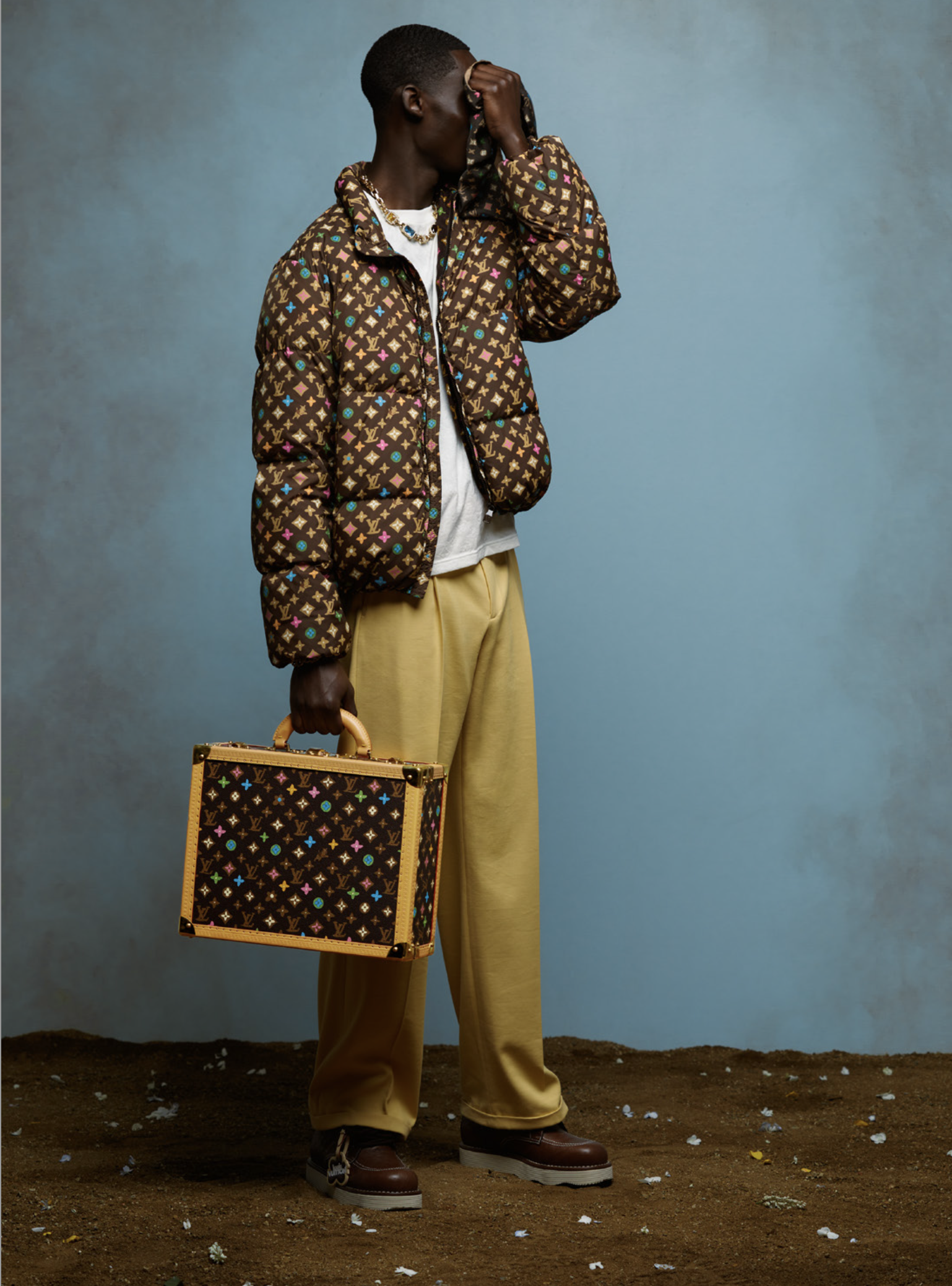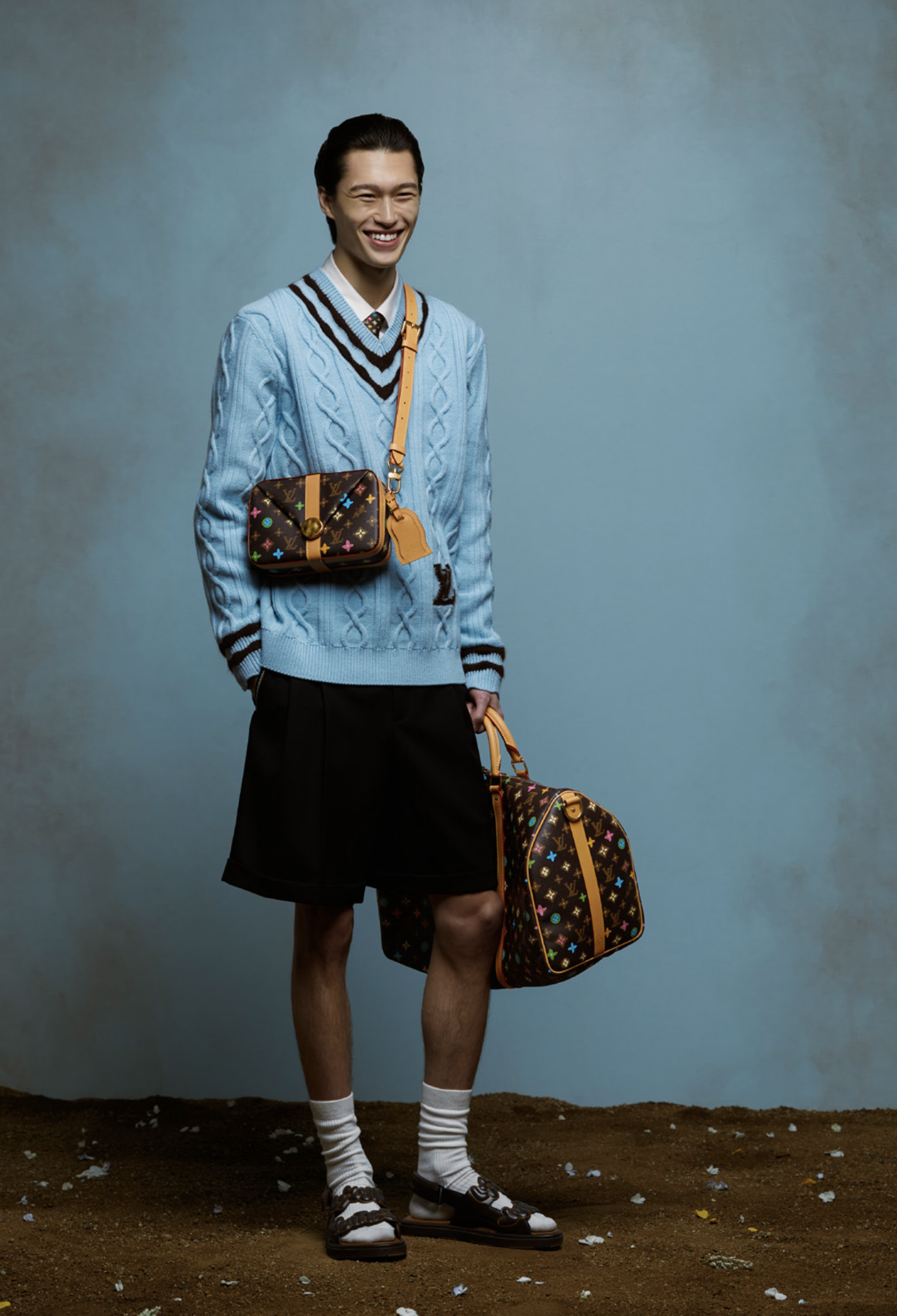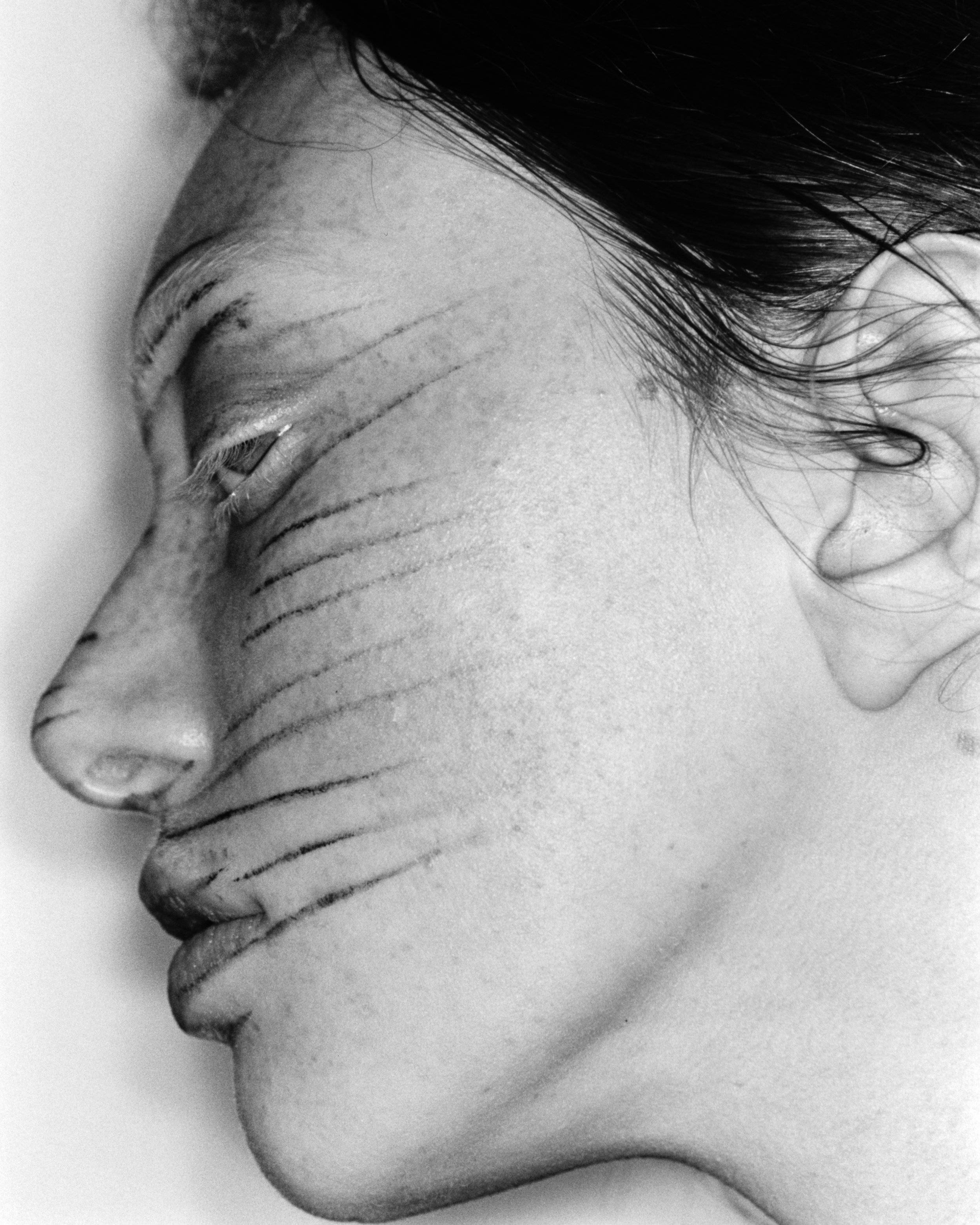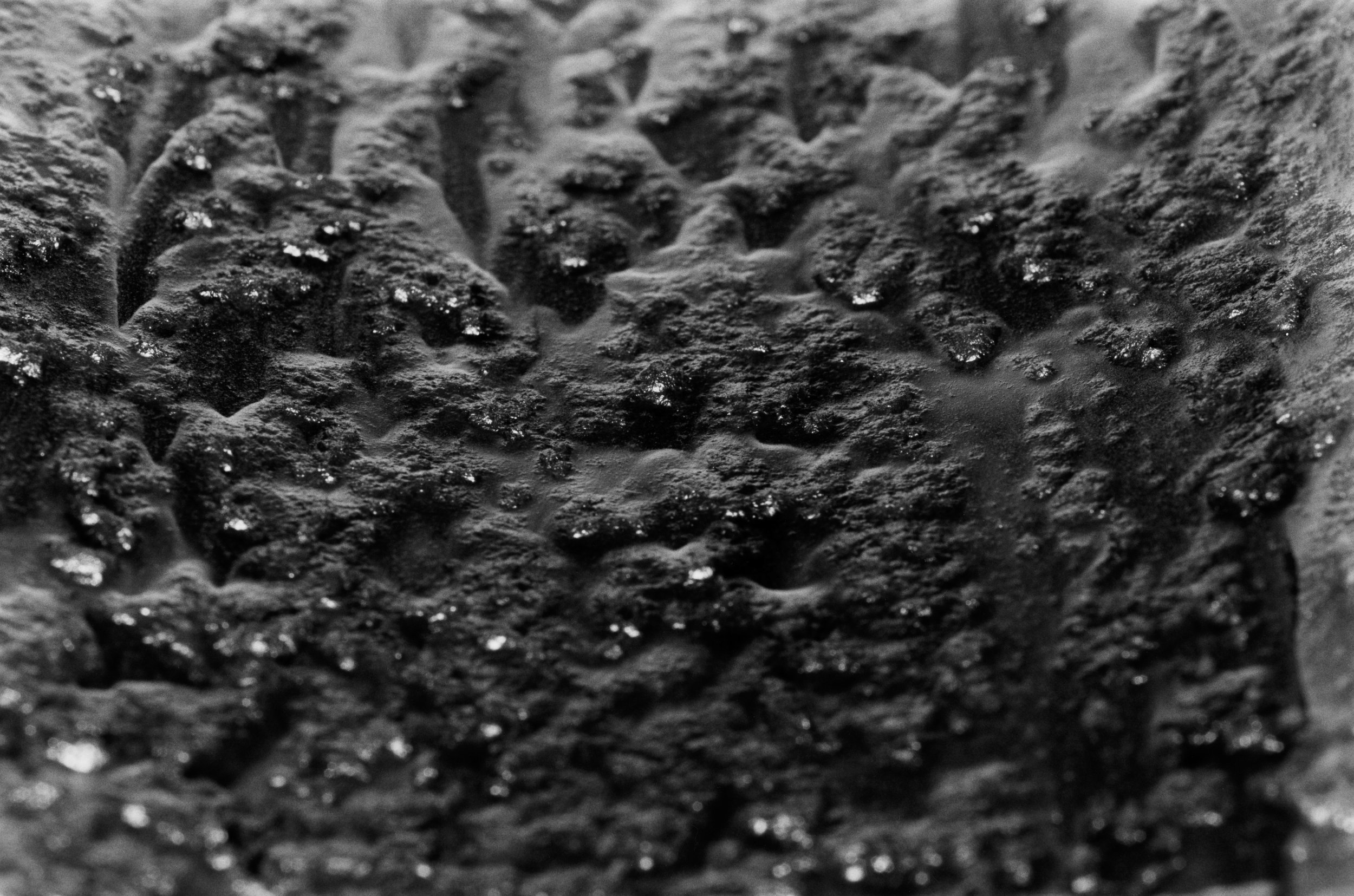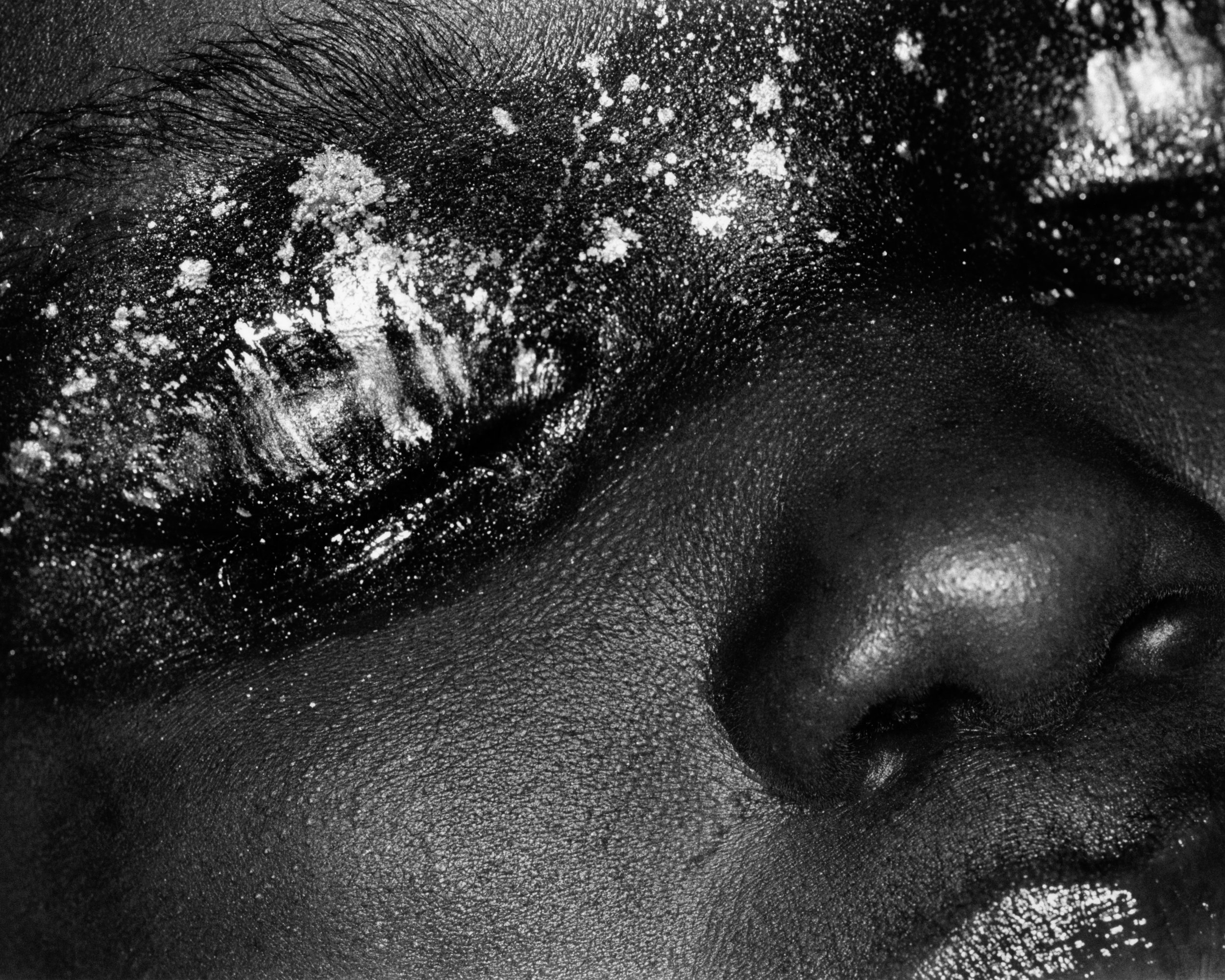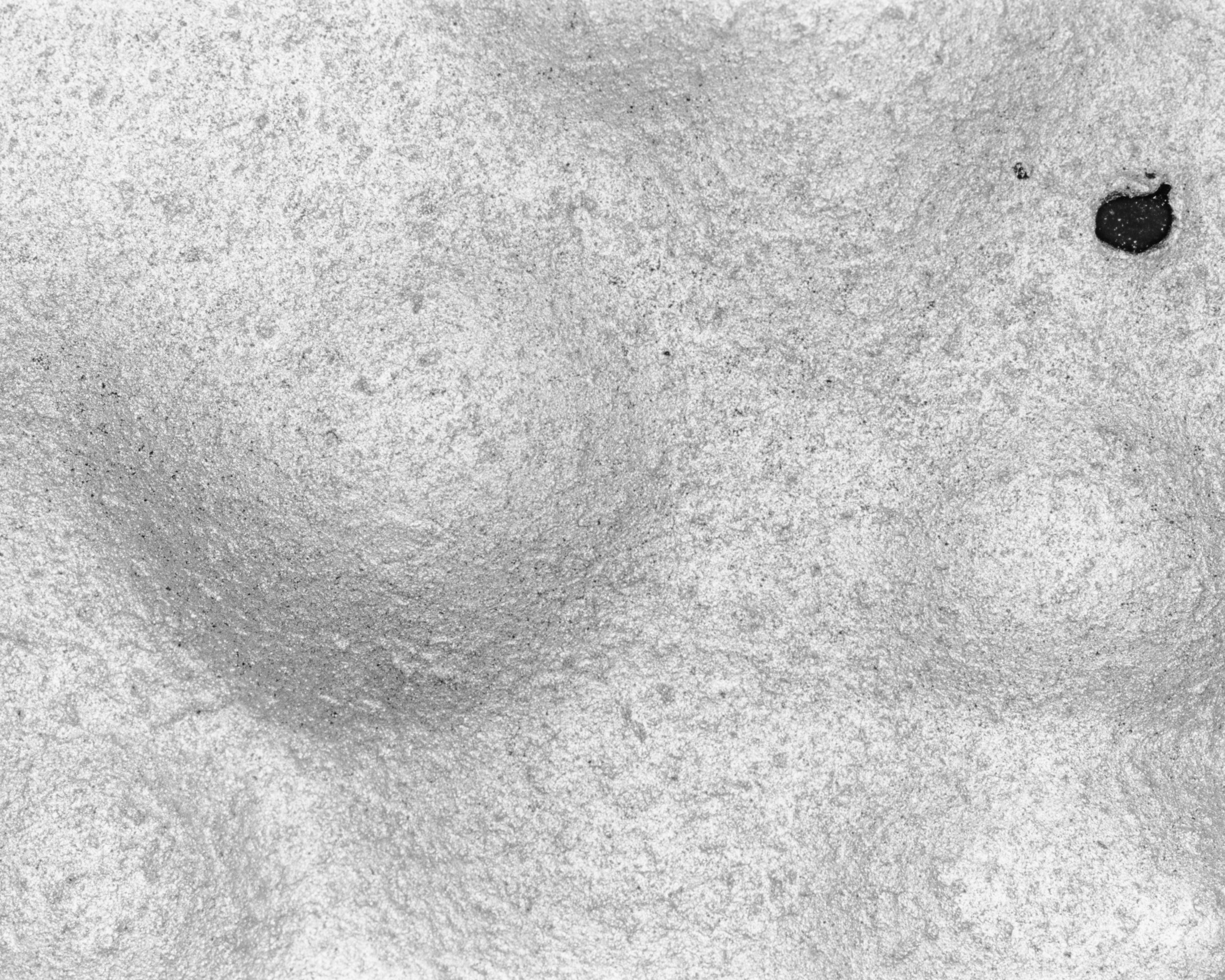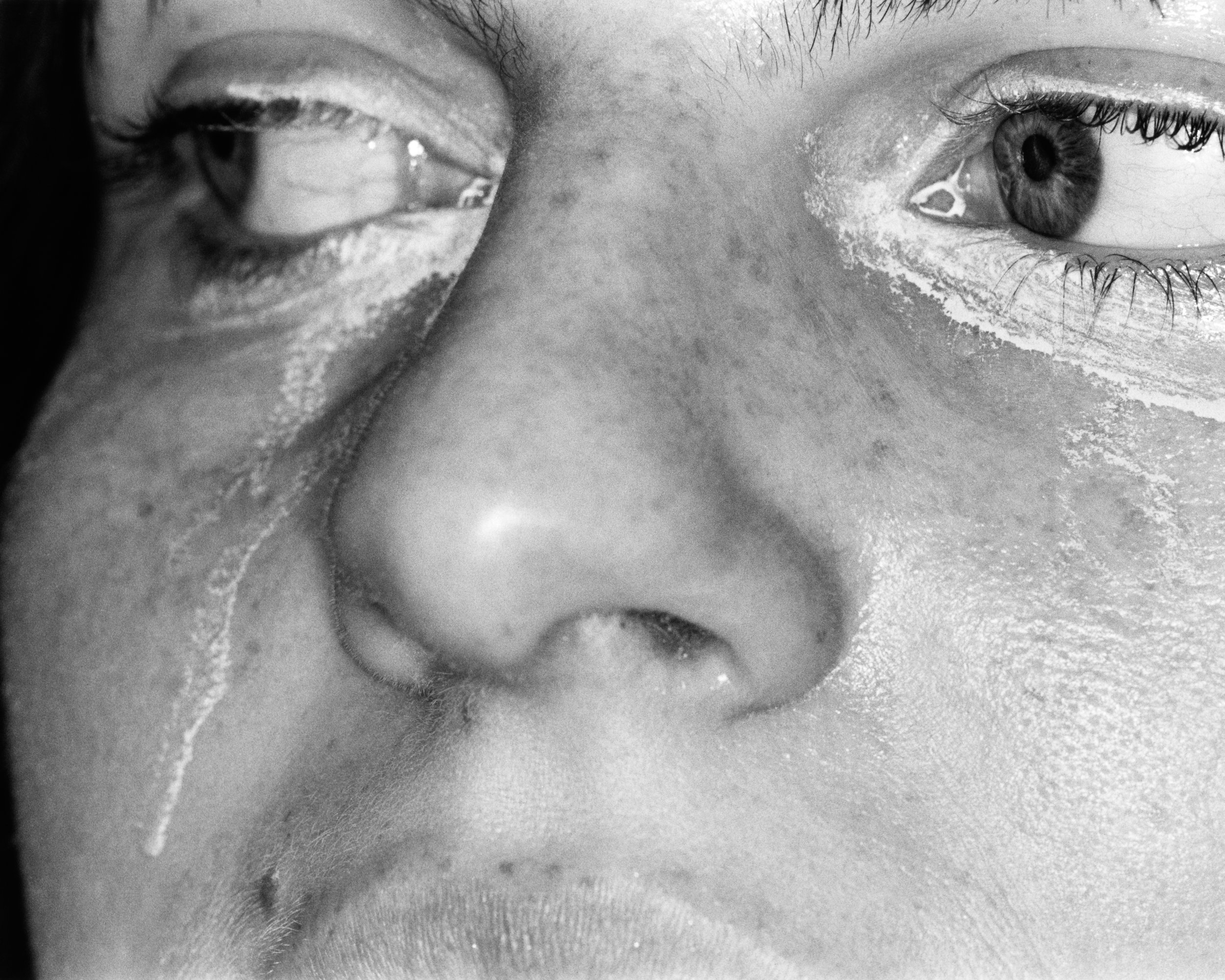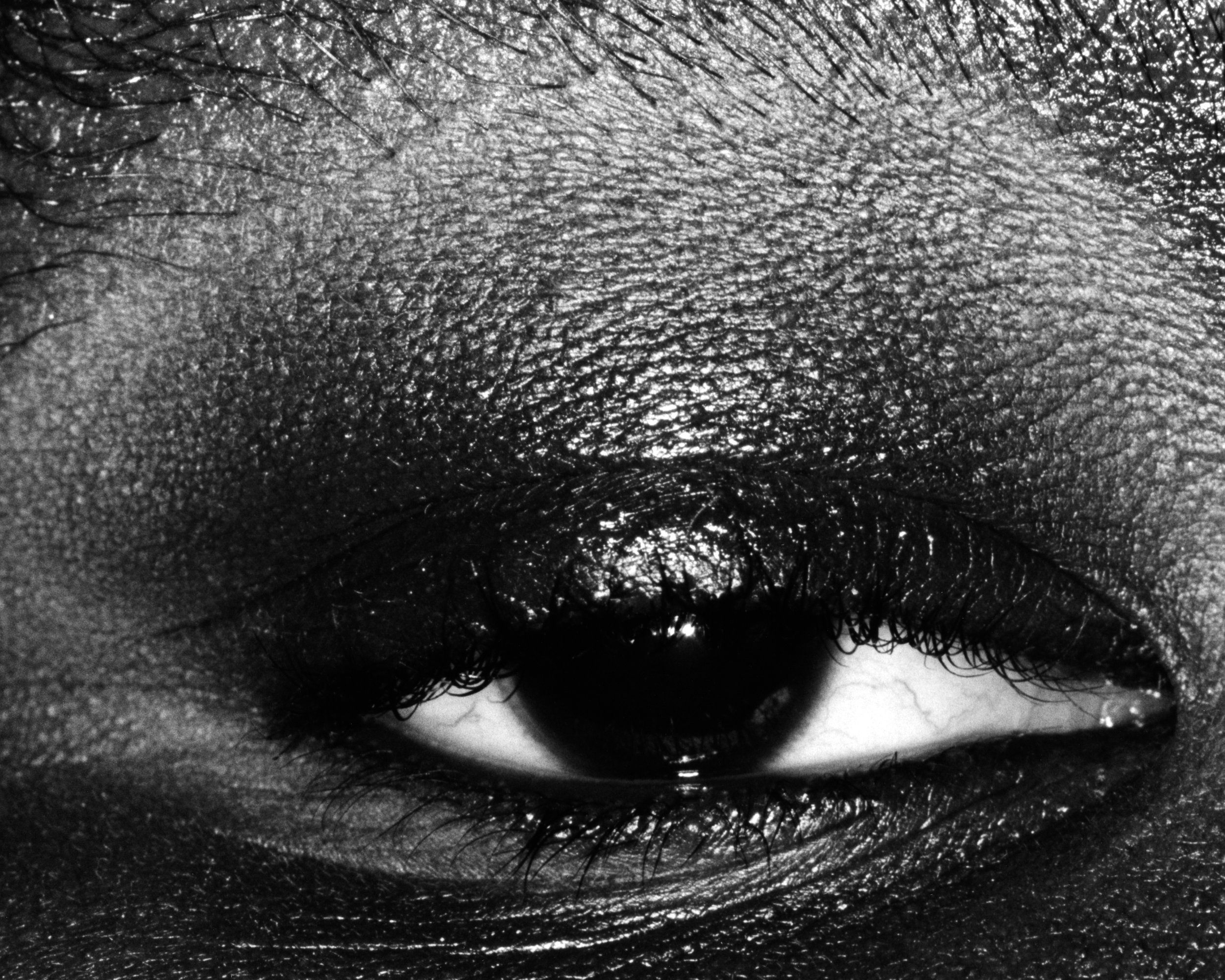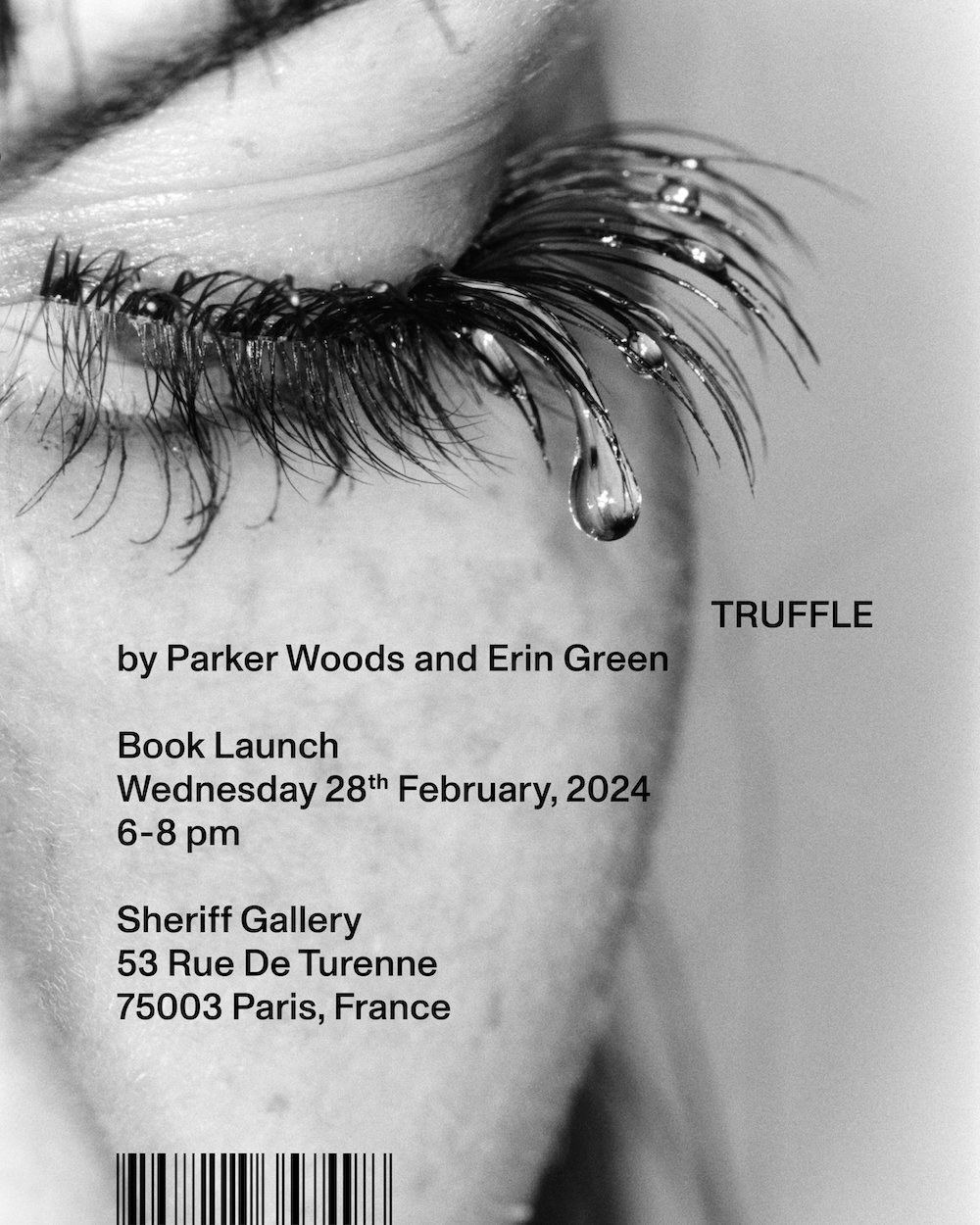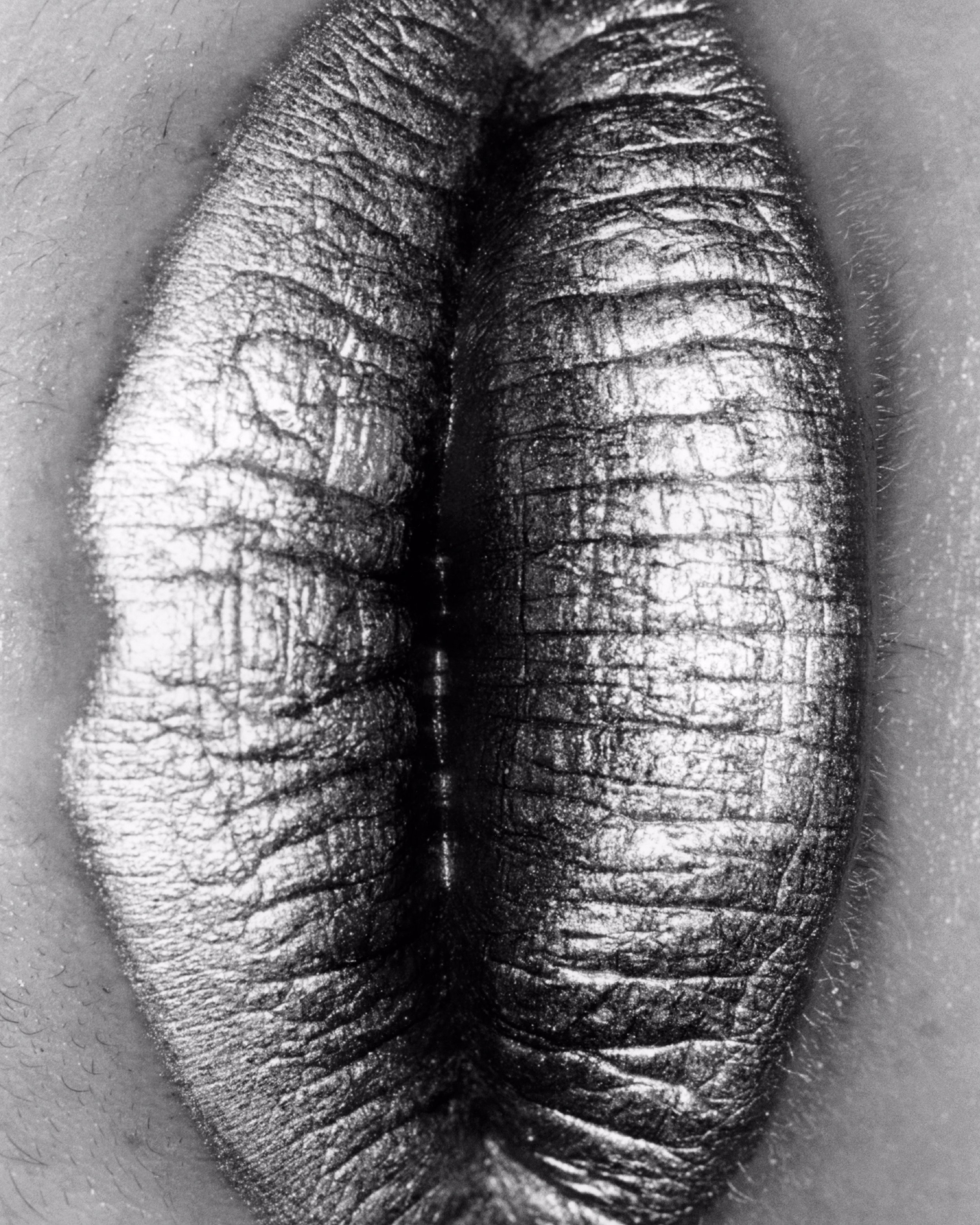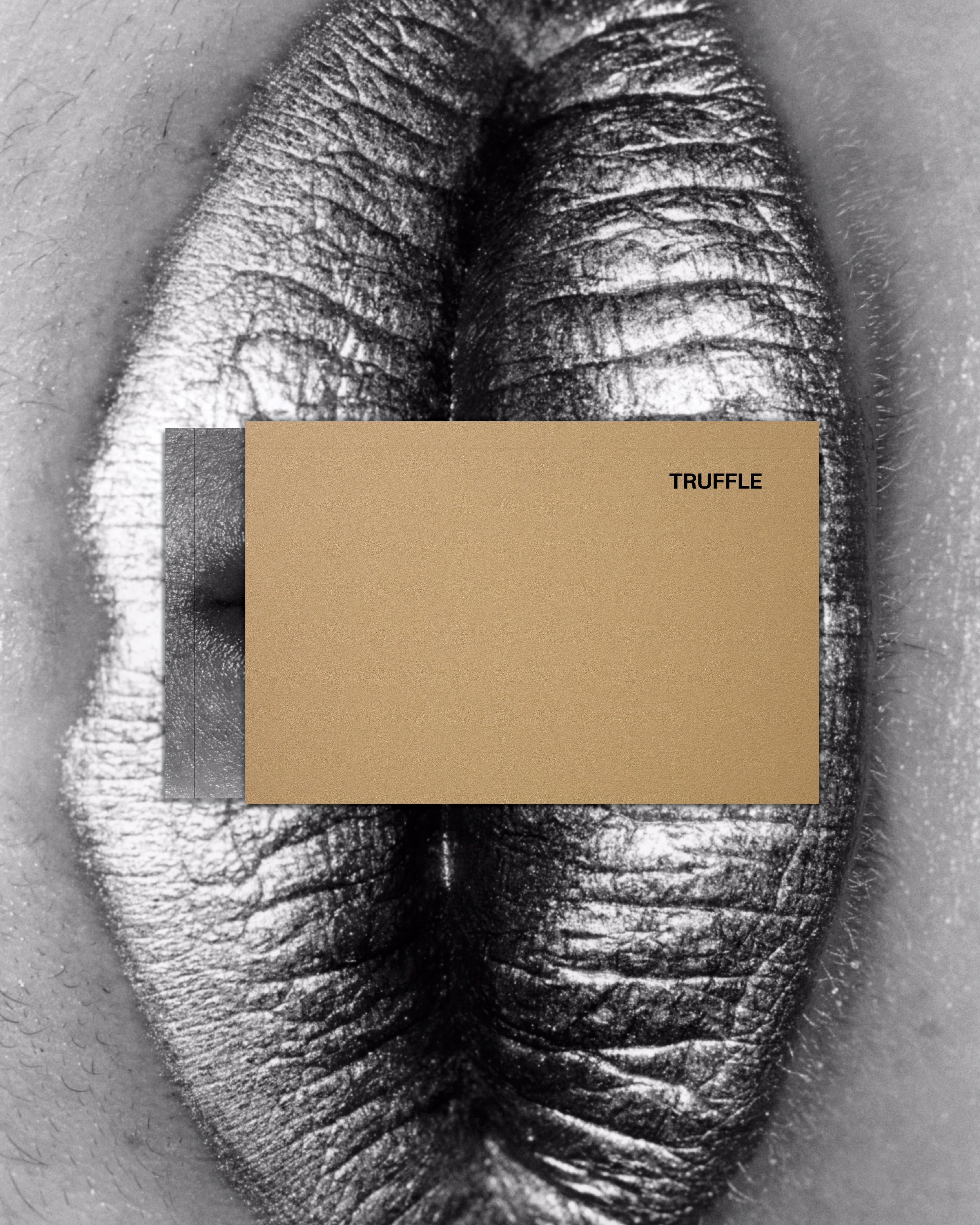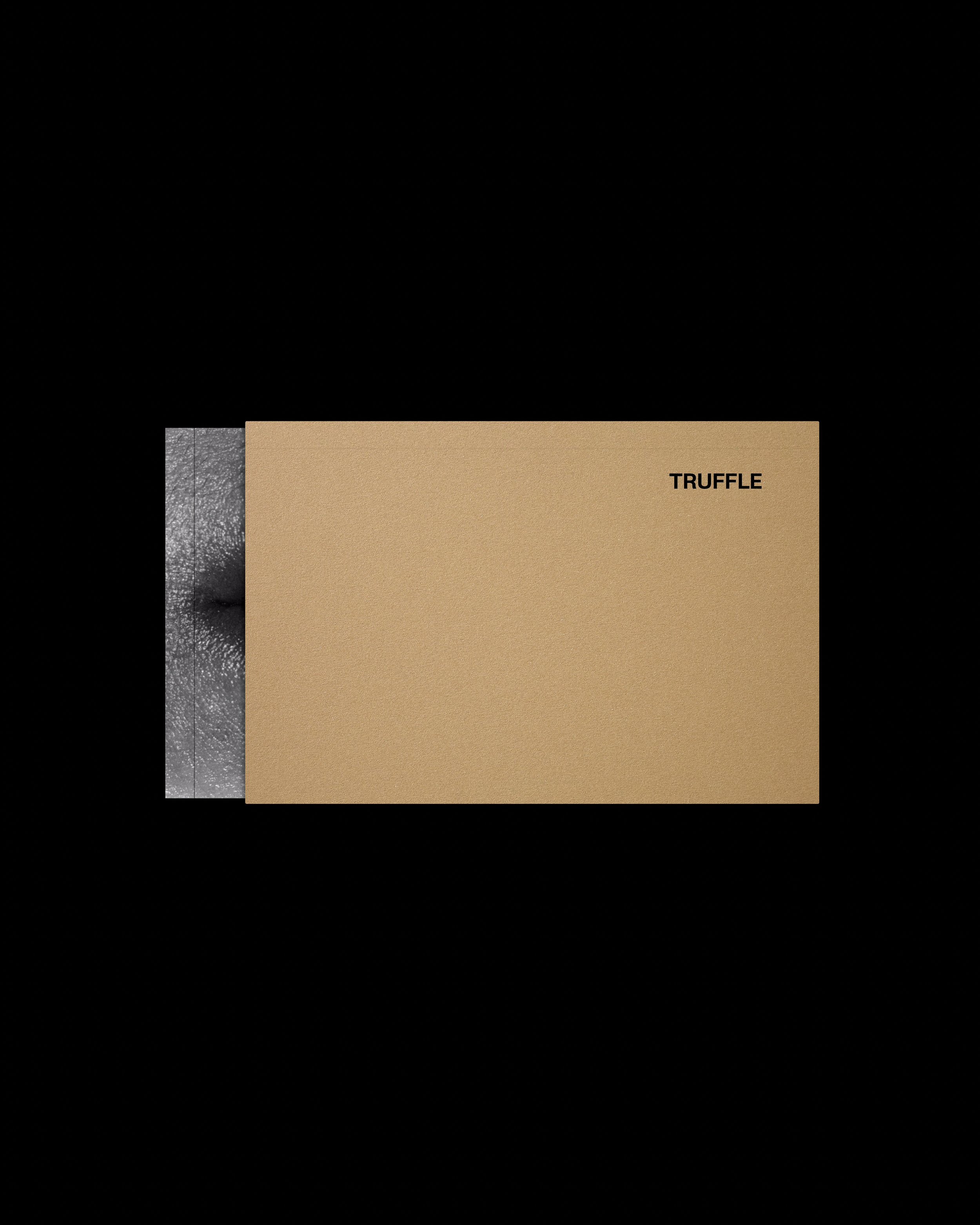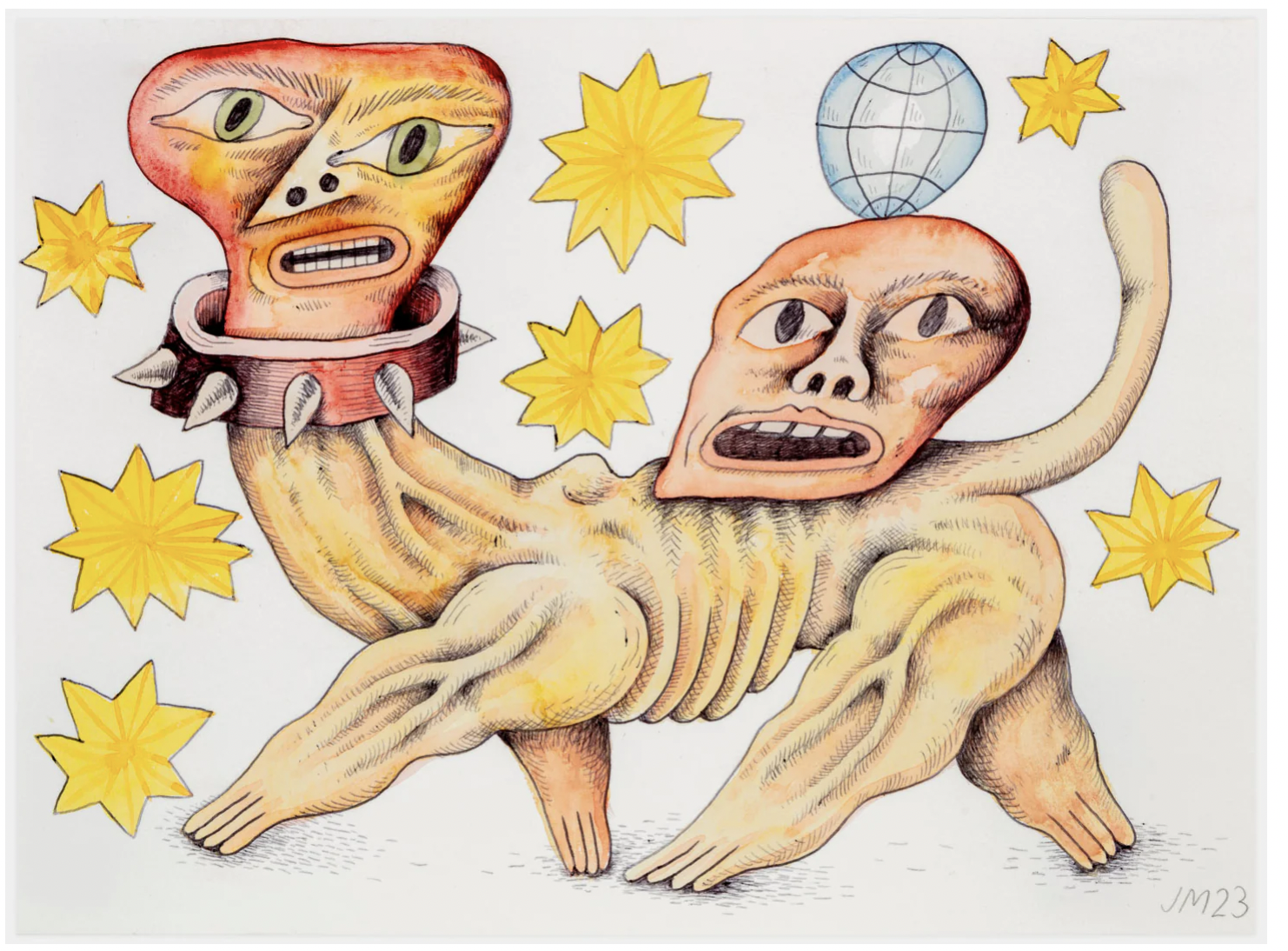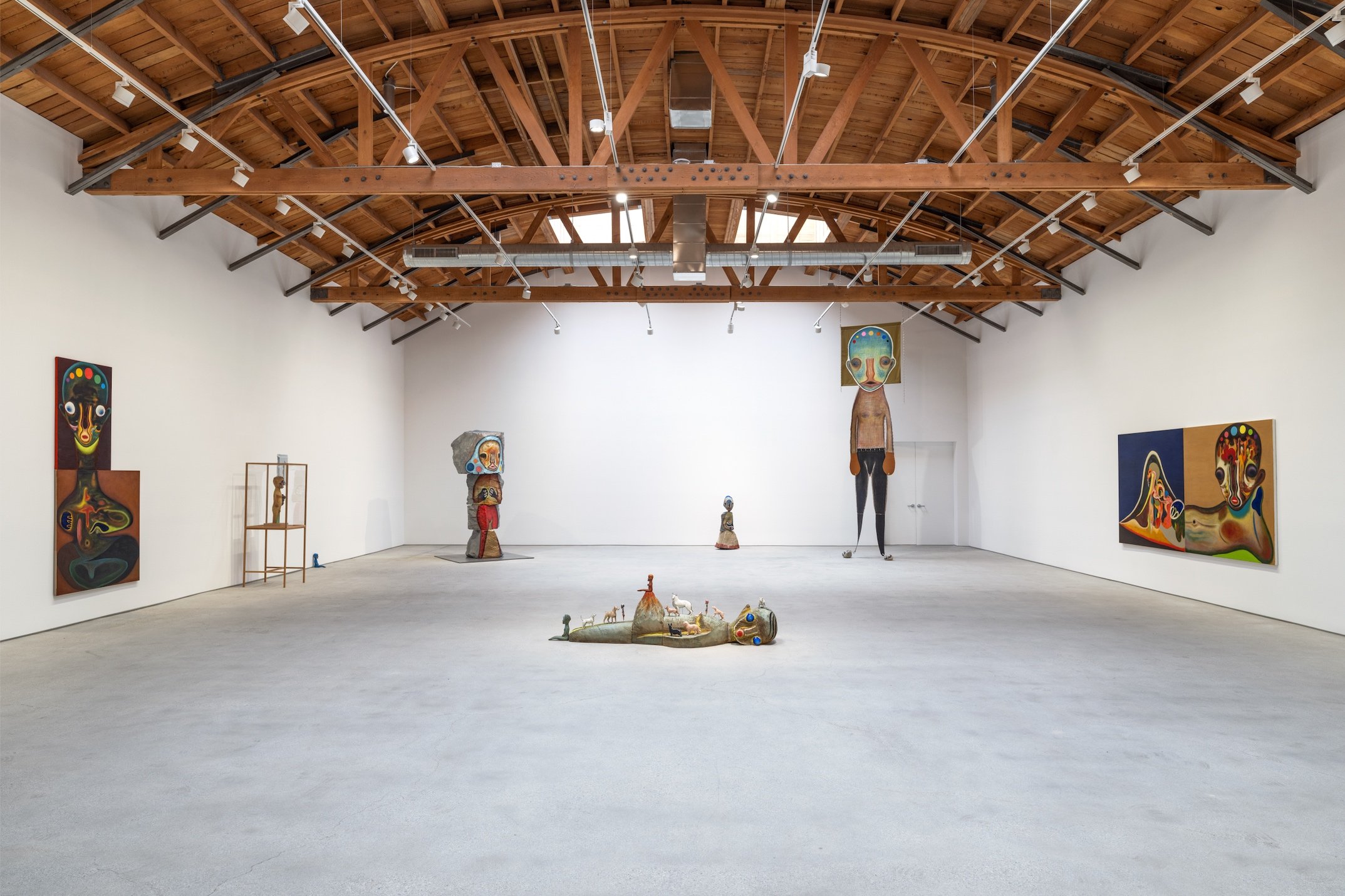Avery Wheless is a Los Angeles-based painter who was born and raised in Petaluma, California. With her mother, a ballet instructor, and her father, an animator for LucasFilms, it’s no wonder she became a painter and video artist with a penchant for the theatrical. Her video works often depict movement artists performing choreography, and her painted portraits often depict everyday people engaging in the unconscious performativity of everyday life. Her current solo exhibition Stage, Presence on view at a private residence in Beverly Hills with BozoMag includes portrayals of the artist and her friends occupying glamorous spaces, caught in moments that subtly reveal the effort that comes with looking at ease. These acts are not celebrated or bemoaned. They just are. One friend reaches into the cocktail dress of another to lift and expose the fullness of her breast in anticipation of reuniting with an ex. Other figures unwittingly become subjects as they applaud an unseen performer or spy pensively on others while sipping martinis. The pageantry of hyper femininity is as vulnerable as it is manicured when you look at it from the right angle and Avery Wheless has a way of depicting it all simultaneously like an emotional lenticular on canvas. Read more.
At the Edge of the Sun Is A Beautiful Amalgamation of Los Angeles' Many Faces @ Jeffrey Deitch in Los Angeles
Photo by Charles White.
Courtesy of the artist and Jeffrey Deitch, Los Angeles.
At the Edge of the Sun is organized by an intimate constellation of twelve artists who have connected over the past decade through artistic discourse and shared experiences of living in Los Angeles. The exhibit convenes works informed by underground economies, California landscapes, night life, local histories, systemic architecture, surveillance, youth culture, public transportation, backyard kickbacks and more. At the Edge of the Sun collectivizes a nod to personal contexts and the artists’ sense of time and place, turning away from familiar mainstream stereotypes of Los Angeles in favor of embracing their own landmarks, memories, communities and visions of their city.
At the Edge of the Sun is on view through May 4 @ Jeffrey Deitch, 925 N. Orange Drive, Los Angeles
Read Our Interview of Artist Tim Biskup On The Occasion Of His 4/20 Exhibition at Face Guts →
American visual artist Tim Biskup is a rebellious outlier in the shark-eat-shark ecosystem of the art market. His project space, Face Guts, is a testament to his anti-establishment ethos. Ceremoniously opening on 4/20, his exhibition Spring Collection will include a new suite of paintings and drawings with Biskup’s unique brand of psychedelia—a vision quest of intuitive gestures and symmetrical forms that play with pareidolia through abstraction. It’s an ayahuasca trip chased by a Freudian drip of haunted symbolism that harkens to Cuban artist Wifredo Lam and maybe the brain scans of enlightened butterflies. Along with new art comes the release of a limited edition yearbook. “Face Guts Year Seven” is a 56-page document of exhibitions, installations, and “whatever else catches the artist’s eye.” Read more.
Poem Of Fire: Esa-Pekka Salonen, Jean-Yves Thibaudet and Mathilde Laurent In Conversation
interview by Oliver Kupper
portrait by Pat Martin
The Greek myth of Prometheus is one of the most powerful metaphors for our current era of emergency. Seeing Earthly mortals living in the brutal, primitive dark, he steals fire from the gods and offers it to humans as a form of technology and knowledge that would become vital to civilization. Knowing that humans would destroy the world with this new resource, Prometheus was bound eternally to a rock by the gods, where his liver was eaten each morning by an eagle and regenerated each night. In 1911, Russian composer and theosophist Alexander Scriabin created Prometheus: The Poem of Fire; a short, powerful composition inspired by the myth. It was intended to be performed not only with sound but also with a synesthetic explosion of lights. In March of 2024, The San Francisco Symphony and Cartier presented a multisensory reimagining of Scriabin’s Prometheus with olfactory curation, led by Finnish conductor and composer Esa-Pekka Salonen, pianist Jean-Yves Thibaudet, and Cartier’s in-house perfumer Mathilde Laurent. Together, they discuss their immersive collaboration.
OLIVER KUPPER The myth of Prometheus, who gave the world fire, light, and inspiration very much fits within the milieu of levity. Through the lens of Alexander Scriabin's piece, what are your definitions of levity?
MATHILDE LAURENT The function of art is elevation. A way towards levity. This work, and the way Scriabin wanted to make all art forms meet, is really important nowadays. I think it helps us find a sense of optimism and light in our lives. Total art was a way to unite art with all the senses. This is where olfaction can help because it’s a very specific path in the brain and in the body. It is the only sense that creates unity between the brain, the heart, and the gut. This is a definition of ecstasy and of transcendence. So, we are here with French pianist Jean-Yves [Thibaudet] and Finnish conductor Esa-Pekka Salonen trying to create a transcendental experience toward light and joy.
JEAN-YVES THIBAUDET Beautiful. I agree with everything you said. God only knows how much we need to be elevated in this world with everything that's going on. That's why music is here too. I think music is the true elevation of the soul. After a concert, people would come to see me and say, “You know, for two hours you made me forget about all my problems, and it felt so good.” We are transporting people both with the music and the olfaction. We are taking them to another world. Now, Scriabin was probably a little crazy, in a good way. He was incredibly ahead of his time. I don't think he could show his pieces in the way we can do it now, certainly not with the lights. So, it was only an invention in his mind. And his music is very unique. You hear one chord of Scriabin and you know it couldn't be anybody else. I remember with Mathilde, when we heard it together—she was listening to it for the first time—how powerful it is. It's a power that is very hard to describe in words. He invented a language of harmonies, of colors. I can't even tell you how many years I've been dreaming about this project.
ESA-PEKKA SALONEN Prometheus is one of the most important myths. Today, we are facing, for the first time in the history of humankind, a moment where we are potentially using the tools we have developed to destroy not only ourselves, but the planet. And of course, it all started with Prometheus on a highly symbolic level. Scriabin’s Prometheus, The Poem Of Fire is technically a piano concerto. It's a piece that doesn't deal with the story in any particular narrative way. It's an expression of the ecstatic moment when Prometheus hands over the fire to humankind, which was, in his opinion, deserving of it. Scriabin was interested in this kind of mystical expression of joy and excitement. He was one of the pioneers of describing sexual love in his music. Not in concrete terms, but the sort of anticipation, excitement, and the climax. Scriabin somehow saw the act of Prometheus stealing the fire and giving it to humankind as not only the ultimate gift but also the ultimate sacrifice, because as we know, Prometheus was punished. So, it becomes almost like a physical manifestation of love. The only reason Prometheus gives the fire to humans is because he loves them. The Greek gods were fairly ordinary people, except that they were immortal. I think that's the center of this: the idea that what makes a life valuable and worthy is the fact that we know that it's finite. Every second counts.
KUPPER It's completely fascinating. Mathilde, you studied as a molecular chemist, which is the perfect background for somebody going into olfaction. Can you talk about your background in that?
LAURENT I wouldn't dare call myself a molecular chemist. I went to university to study chemistry, but I did not perform well. I only got my degree in chemistry to become a perfumer. I was scientific enough to get a degree. (laughs)
KUPPER What was it about olfaction that inspired you to begin with? I'm curious what your first memories of perfume were.
LAURENT I came to perfumery to express myself about the world and beauty—to offer something and to have a dialogue with other people. When I was a child, I was not only seeing and listening, I was smelling, touching, and tasting everything. I was hypersensitive. So, when I was thinking of choosing a job, I hesitated between architecture, photography, and perfumery. I was creative, so I needed a job with artistic expression. I was about to become a photographer, but then something interesting happened. I got a job writing articles for different psychoanalysts and scientists who were learning how a perfumer's brain works. This is when I realized that photography and perfumery are totally linked. Each smell has a photograph and each photograph has a smell.
KUPPER Both are very connected to memory.
LAURENT Exactly. They work together. I cannot smell something without printing an image in my mind. And now, I know that the brain works like that. You can register a photograph without the smell, but you cannot register a smell without a photograph of it. It’s the olfactory path I was speaking of previously. When you smell something, all of your senses are activated. Each time you detect a certain smell, you will come back to where you were, eating what you ate, listening to what you listened to, and feeling the same emotion, whether it’s a good or very bad one.
KUPPER It's very Proustian. Jean-Yves, I want to talk to you about your beginnings as a pianist because you were performing from a very young age.
THIBAUDET I was seven—a late bloomer. Growing up, I felt very lucky because I never thought of doing anything other than music, in particular, the piano. All my friends were having nightmares, saying, “We go to bed and think: what am I going to do when I grow up?” It was very heavy. So, I felt lucky. I said, “Well, I'll be a pianist.” I didn't know what it meant, but I thought it would just happen. My parents were not professional musicians, but music was very present at home and there was a piano. I also remember the sound of my father playing the violin. Music is almost like a smell for me. Music is also very much connected to memory and the brain in the same way that the other senses are.
KUPPER It's interesting that music and scent both have the language of notes. Mathilde, how did you write this score through the notes of olfaction?
LAURENT I just had to listen to the music. What I wanted to express through olfaction is what Jean-Yves and Esa-Pekka wanted to present to the audience through the music. So, I needed to have them tell me what they were feeling when playing, and the meaning of the different moments of the piece. It was about listening and sharing, and understanding the different instruments. We all agreed on three different areas in the piece: before the fire, the moment when the fire appears, and after the fire. Before the fire, the world was a dangerous place where man had to survive against thunder, cold, and wildness. Nature was an enemy. Immediately, I smell this place and I only have to evoke it: the smell of thunder, the smell of water, of ice, of anxiety, of cold nature, of wild vegetation, of humid earth, of stones.
KUPPER Esa-Pekka, when this was brought to you, how did you imagine the symphony hall adapting to this new olfactory technology?
SALONEN It's all about technology because every attempt to combine music and scent generally fails. We all know from experience that perfume lingers, because the alcohol, which carries the scent molecules, takes time to evaporate. Over a number of years, technology was developed to dry diffuse molecules without any carrier, which means that the experience is instantaneous and finite. You can accentuate things with the scent, and you can also regulate the intensity of it. It's all WiFi-controlled. I went to see Mathilde in her lab in the Fondation Cartier building, pre-pandemic. I was expecting to see a Severus Snape type of person mixing these vials. But no, her lab was all white with iMacs everywhere. And I said, “Mathilde, how do you create a scent? Do you experiment with various components and then come to the right one?” And she said, “Oh, no, no, no. Quite often, I conceive the scent in my dreams.” And then, she wakes up and writes it down. But she doesn't write it down as “This was the smell of daffodils in a field on an April morning.” She writes down an actual molecular formula. So, I realized that this is a highly sophisticated thing based on science and theory as much as sensitivity to fragrances. She had made thirteen scents based on Remembrance of Things Past, the big seven-part novel by Marcel Proust. And the scents were stored in leather boxes with nothing to see inside—just the molecules, I guess. So, she opens the lid and I sniff one called l’Heure Perdue, the most Proustian one, she said, because it’s about the smells of childhood, of grandmotherly things. It's interesting because my grandmother was not a very good cook. She was not particularly warm as a person. There was very little that was grandmotherly about her. She definitely didn't bake cookies. I was smelling the sort of archetypal “good grandmother” and that was astonishing. I said to Mathilde, “This takes me to a childhood I didn’t have. It’s somebody else's story, not mine, but it's pleasant nevertheless.” It’s powerful.
Read the full interview in Autre #18 The Levity Issue (SS24). Click here to preorder
Read Our Interview of Paris-Based Artist Ladji Diaby →
April 11th marked the opening of Preservation, a group show curated by Paige Silveria and Paul Hameline at CØR Studio in Paris. The exhibition brings together a disparate group of artists (including Ladji Diaby, Alyssa Kazew, Mark Flood, Gogo Graham, Jordan Pallagès, Anthony Fornasari, Bill Taylor, Caos Mote, Ron Baker, Cecile Di Giovanni, Simon Dupety, Gaspar Willmann, Wolfgang Laubersheimer, and the late, great Gaetano Pesce) whose work ranges from photography, collage, video, design, sculpture, and more. These works explore the original purpose of our human intellect before it became aware of itself and started to ask the unknowable. They reflect on a time when the self wasn’t yet conscious and only concerned itself with preservation in the most existential sense of the word. On the occasion of the opening, Paige Silveria spoke with artist Ladji Diaby to learn more about his roots in Mali, his creative process, and his relationship to the art scene in Paris. Read more.
Balenciaga's Le City Bag Returns With a Nod to the Early Aughts
First launched in 2001, Le City has become synonymous with an era and a lifestyle known for its enigmatic maximalist yet practical approach. Over twenty years since its initial debut, Le City makes a comeback as a reconstituted icon.
To celebrate the launch, Balenciaga unveils a campaign of portraits shot by Mario Sorrenti that highlights the brand’s newly reintroduced early aughts design that featuring British fashion icon Kate Moss, Danish model Mona Tougaard, Chinese actress and singer Yang Chaoyue, and Korean singer Juyeon. The individuality of each talent is foregrounded against a grey background in striking still images and videos.
Read Our Interview of Holly Silius on the Occasion of Her Solo Exhibition @ Central Server Works in Los Angeles →
Holly Silius. George Clinton, 2023. Stone and gold leaf.
“I don’t have to sell my soul, he’s already in me” read the lyrics of The Stone Roses’ groundbreaking hit track “I Wanna Be Adored.” Perfectly salient in their minimal simplicity, they defined a generation who watched their idols on television with a yearning desperation for recognition. Los Angeles-based sculptor Holly Silius was in her youth living in Manchester at the time. It was the end of Thatcher’s era of neoliberal deregulation with its flagrant embrace of conspicuous consumption that made so many of her peers feel a hollow ennui; a listless lack of purpose that left them looking ahead to the next millennium without the slightest clue of where they fit in. Thirty-five years later, Generation X finds itself in an era of social media where everyone can build a virtual platform from which to project their image and ideals. Silius now finds herself adorning and casting the faces and bodies of countless people—some with humble followings, some with household names—studying their every angle to capture the elusive essence that makes them so alluring as subjects. Read more.
Scarlett Johansson Stars in New Prada Galleria Campaign Directed by Jonathan Glazer
Talent: Scarlett Johansson
Director: Jonathan Glazer
Creative Director: Ferdinando Verderi
An actor is ceaselessly reinventing, and reinvented, transcending their own selves to embody the myriad of characters they can become. Here, the magnetic draw of the movie star is harnessed as a means of connecting to character, to personality, and to that constant shifting of identity that emblematizes both film and fashion.
Captured in New York City by director Jonathan Glazer, the still and motion images showcase Johansson as an actor, honing her art — repeating phrases with different feeling and meaning, she showcases the infinite self-transformation that define an actor’s skill. Abstracted, unreal, it is film at its most cinematic. Yet, as Johansson exits the studio, we then leap from screen to reality — albeit a reality fictionalized, idealized for us. In a quintessentially Prada dichotomy, the intimacy that the act of performing is able to generate contrasts with a panoramic normality of everyday life. Cinéma vérité — Johansson, seemingly undirected, as her true self.
The instrument of Johansson’s everyday is the Prada Galleria handbag, seen here as a tool of life rather than a product, a part of an everyday wardrobe. As with Johansson its persona can transform; as with acting, it is a symbol of excellence in craft. Here, the Prada Galleria is showcased, in motion, as a fundamental facet of a woman’s reality.
PREORDER AUTRE #18 SPRING/SUMMER 2024: THE LEVITY ISSUE →
Click here to preorder
GENDERQUAKE Is A Temporal Distillation of Fashion's Evolution @ SCAD Museum of Art for SCAD deFINE ART 2024
An ode to the evolution of fashion from the 20th century to the present day, GENDERQUAKE: Liberation, Appropriation, Rejection represents the progression of the fashion protagonist through time. The group exhibition is an amalgamation of fashion’s trending extremes, representing the strategic placement of garment on the body. The show assigns nuance to the body in form and the way clothing chooses to rest. The corporeal identity celebrates the dynamic nature of gender; its emphasis lies in the multiplicity of form and operation with the growing milieu. Light is strategically implemented here; coloration is obscured and distorted recurrently so that color takes preference over form and form takes precedence over color. We are led to examine the multidimensionality of attire in its own context. The augmentations of light are fleeting; the shift is gradual, but with each minute transposition one is delicately subdued into another reality, another dimension, to another way of seeing. We move linearly through time and metaphysically through light. GENDERQUAKE epitomizes fashion’s unique relationship to timelessness.
GENDERQUAKE is guest-curated by Stefano Tonchi with Marta Franceschini and presented as part of Savannah College of Art and Design (SCAD) deFINE ART 2024 through June 24.
All images courtesy of SCAD.
SPLAT: A Sensory Play Party & Performance By Bobbi Salvör Menuez @ Performance Space New York
“Sometimes performing, leaking always, together” reads the subheading of Bobbi Salvör Menuez’s SPLAT, a sensory play party at Performance Space New York, where the multidisciplinary artist also gave a private performance. Guests had their tongues painted by Early Shinada in quori theodor’s gnaw installation, brought towels for “slime hour” in the “splash zone,” were offered beverages and a place to communally shower in the bathroom before engaging in some dry, quiet play in the “soft zone,” and documented themselves while traveling through the “liminal zone.” All guests had stickers placed over their phone cameras, so the only documentation of the night came from within an interactive, live-feed macrophilic installation resembling a giant mouth titled I’m Big, You’re Small. All attendees were asked to take rapid Covid tests before attending and encouraged to engage in consensual cruising and play. A house manager could be found on site to support in all ways necessary and voyeurs were received with a warm welcome.
The Perfect Specimen: Read Our Interview of Lauren Lee McCarthy On Her Exhibition "Bodily Autonomy" @ Mandeville Art Gallery In San Diego →
Installation view, Lauren Lee McCarthy: Bodily Autonomy at UC San Diego Mandeville Art Gallery. March 2-May 25, 2024. Photo by Pablo Mason. With support from Creative Capital.
When asked to read through a long list of terms and conditions before giving consent, most of us have developed a reflexive response of scrolling to the bottom and trudging ahead. There’s a miniature risk/benefit analysis that we all conduct, which includes a completely unknown potential risk in the distant future, and the near future benefit of moving on. Time is such a valuable commodity that we regularly find ourselves sharing everything from personal data, browsing data, biometric data, and more. Oftentimes, there’s no contract at all. You may have thought you were showing all of your friends how your looks changed from 2009 to 2019, but you were really training someone’s private surveillance software. The list of myopic, nefarious applications that we serve by giving ourselves away to faceless data farms in exchange for what often amounts to a forgettable laugh is endless. In Lauren Lee McCarthy’s Bodily Autonomy exhibition at UC San Diego’s Mandeville Art Gallery, she explores two very specific aspects of the way that we engage with science and technology. With “Surrogate,” she created an application where couples and individuals who are interested in hiring her as a surrogate mother are invited to dictate everything from her eating and sleeping habits, to her daily activities, and more. While these requests are not actually fulfilled, the application itself challenges notions of reproduction, genetic selection, and commerce. With “Saliva” she has created a saliva exchange station that is activated every Thursday from 6-8pm where visitors are invited to give and receive samples of their own saliva. Each participant is given agency to label their sample as they prefer and they provide the conditions for what happens to it (scout’s honor). Doreen A. Ríos, a PhD candidate in Art History, Theory, and Criticism at UC San Diego and an independent curator and researcher, spoke with McCarthy to discuss the implications of these technologies and the imperative within the work to embody a more transparent form of participation. Read more.
Read an Interview of Holly Hendry on the Occasion of Her Exhibition @ SCAD Museum of Art for SCAD deFINE ART 2024 →
Holly Hendry, Her bones begin to bend, 2024. Image courtesy of SCAD.
Holly Hendry’s Watermarks, featured at the Savannah College of Art and Design (SCAD) Museum of Art through June 24, is a site-specific oasis which playfully investigates the way water runs through virtually every facet of human life. Situated outside the museum in glass vitrines overlooking Turner Boulevard, Hendry’s four sculptural pieces encounter the world in an unconventional way. The architectural display is situated in the community; students pass it every morning on their way to class. The significance behind the work in this context becomes ever-evolving, effortlessly aligning with the shifting elements of the everyday. Her edifices traverse intricate concepts that range from the expansiveness of architecture, societal conceptions of the female form, to the connectivity of bodies via water. Interestingly balancing the lightness of uplifting artistic figuration with the weight of impending doom as it relates to our not-at-all-ubiquitous freshwater supply, Hendry’s sculptural forms are dynamic manifestations of life on earth. Read more.
Watermarks is organized by SCAD Museum of Art chief curator Daniel S. Palmer with assistant curator Haley Clouser and presented as part of SCAD deFINE ART 2024.
Louis Vuitton's Spring 2024 Men's Capsule Collection Is A Fusion of Visions
creative direction by Tyler, the Creator and Pharrell Williams
Louis Vuitton’s iconic imagery is a staple in the fashion world, unique and identifiable amidst the ever-changing tides of trends. Despite this classic style that cements the brand’s singular voice, their ability to evolve and innovate that image is constant. The 2024 Men’s Capsule Collection displays this innovation while still staying true to the brand’s face by staging an instinctive union between the visual universes, combining the distinctive artistic voices of the Menswear Creative Director Pharrell Williams with long time friend of him and the brand, Tyler, the Creator. Fusing the signature preppy sophistication popularized by the artist with the elegant dandy dressing established by Pharrell Williams at the Maison, it evokes the brand’s common palette of earthy creams and browns, as well as muted yet still vibrant blues and greens to support the pops of bright color that bring the air of spring into this lineup. The emblem of the collection being a craggy monogram, hand-drawn by the artist himself. Throughout the collection you can feel the creative collaboration take place and see the marriage of these two’s strong visions come together.
TRUFFLE by Parker Woods and Erin Green Book Launch @ Sheriff Gallery
TRUFFLE is an ode to detail; with the combining forces of Parker Woods’ intimate style of photography that takes a fresh approach to abstraction by placing it within the context of humanity, as well as Erin Greens’ honest and raw makeup artistry, depicting more than just makeup—but the person behind it. The book proposes a perspective one could only define as close, in all ways. Work that prides itself on defying the very word “pristine.” TRUFFLE’s black and white imagery along with their mix of up-close shots displaying both identifiable human features drawn in makeup amongst abstracted textured imagery creates a unique voice that speaks to you like a whisper directly into your ear. Portraying not only up close intimacy, but an undeniable vulnerability that compels you to look, even if it feels invading, the art book stands out by its artistic approach that can only be described as honest.
With graphic design by Patrick Slack and Austin Redman, the final object is a 208-page, landscape-oriented book with slipcase and a 40.64cm x 50.8cm double-sided poster. Edition of 200.
You can preorder TRUFFLE now on their website
Read Our Interview Of Artist Jim Mooijekind On The Occasion Of His Solo Exhibition In LA →
Click here to read more.
Lefty Out There "Tempus" @ Maddox Gallery in London
An exploration of time through the lens of growth, energy and artisanship, ‘Tempus’ is Lefty Out There’s most complex and intricately crafted show yet. Envisaging a show entirely in color, his sophisticated palette is intertwined with multidimensional shapes, forms and proportions. Exploring just how far he can push his abstractions, his trademark polymorphs breathe and grow as the exhibition unfolds through more than 30 unique works.Hailing from Chicago, Lefty’s immersion in the city’s buzzing street art scene marked the start of his career-long obsession with patterns. Always chasing perfection, his studio in Los Angeles is part traditional artist’s atelier, part experimental workshop. Harnessing the power of machinery, technology, carpentry and a myriad of different mediums and techniques, the new works reflect the patience and passion Lefty invests in every stroke and contour. Tempus will be on view until May 4th at Maddox Gallery, 12 Berkeley Street, London
Read An Interview Of Kate Mosher Hall On The Occasion Of Her Solo Exhibition @ Hannah Hoffman In Los Angeles →
Kate Mosher Hall, 31,556,952 seconds, 2024
Acrylic and charcoal on canvas
80 x 72 inches (203.2 x 182.9 cm)
I recently visited Los Angeles born-and-raised painter Kate Mosher Hall at her light-filled studio in a bricky industrial area of Glendale. With the 5 freeway buzzing nearby, she walked me through her complex and unique process, which involves silkscreening light-sensitive emulsion over gessoed canvas using anywhere from eight to thirty screens depending on the particular painting, Photoshopping, layers of collage, and paint. It’s a “choose-your-own adventure” as she says, to get the desired effect. To help organize things, she’s created a lexicon: box paintings, hole or mesh paintings, recursion paintings. Some paintings incorporate elements of all styles. Hall, a punk drummer, worked in silkscreen studios for several years before she began UCLA’s Fine Art MFA program. We talked about Never Odd or Even, Hall’s second solo exhibition at Hannah Hoffman, which is currently on view in Los Angeles and the way that the work employs both good and bad math, challenges modes of looking, and the infinite repetition within binary relationships. Read more.
Izumi Kato's Not-Quite-Human Figures Are Apparitions of Coexistence in Perrotin's Inaugural Los Angeles Show
#6
Untitled, 2023
Photo by Kei Okano
Courtesy of the artist and Perrotin ©2023 Izumi Kato
Perrotin inaugurates their new Los Angeles location with an exhibition of work by Japanese artist Izumi Kato.
Imagine, for a moment, that Izumi Kato’s figurative subjects have a life of their own. From the artist’s studio in Tokyo, his subjects have traversed the ocean, crossing the Pacific to emerge in Los Angeles. Making their way to Pico Boulevard, they appear utterly at home in Southern California—a place where one can encounter the extremes of both prehistoric geology and urban modernity, where tar pits coexist with gleaming new buildings, where eternal ocean cliffs abut concrete highway. These binaries of ancient and modern, geological and man-made, are dualities that also coexist in Kato’s work, making his exhibition a fitting choice for Perrotin’s inaugural exhibition in Los Angeles.
Izumi Kato’s exhibition is on view through March 23 @ Perrotin in Los Angeles, 5036 W. Pico Boulevard
Miu Miu's Fall/Winter 2024 Collection Traces Life From Girlhood to Womanhood
The Miu Miu Fall/Winter 2024 collection by Miuccia Prada draws inspiration from the span and scope of people’s lives, its shifting clothing types reflective of the development of character, both personal and universal to form a vocabulary of clothing, from childhood to adulthood.
Concurrent gestures express different moments in life — they coexist within single outfits, just as we each hold simultaneous memories of our own experience. Evocations of childhood are expressed with deliberately shrunken proportions, cropped sleeves, and round-toed shoes; archetypical clothing types that directly recall those worn in youth. Childhood is a moment of impulsive, natural rebellion, here reflected in the liberation of a dichotomous mixing of different codifications of dress, pajamas with outerwear, proper with improper, right with wrong. By contrast, adulthood is expressed through recognized signifiers of propriety and chic — gloves and handbags, brooches, tailoring, the little black dress. Like mnemonic devices, clothes can make us both think back, and project forwards.
Those components of duality and recollection find counterparts in materials and construction. Bonding and fusing meld together different fabrics and combine disparate garments, sweaters and cardigans in silk and cashmere, poplin skirts with knit, while shearling is treated to mimic precious fur. Silk dresses are creased and molded to cotton jersey sheaths, volumes reduced with the impression of the original garment remaining, a trace of its antecedent.
As the collection reconsiders characteristic signifiers of life through the vocabulary of clothing, so our literal vocabulary can be readdressed. Girlishness is a word we can revalue, from a pejorative gendered noun, anchored to age, to a universal idiom expressive of the strength of rebellion, a spirit of freedom and individuality, one attribute of a richer whole. Perceived as an inherent component of Miu Miu, it should be examined not as a lone trait but as a fundamental aspect of a wider temperament — a notion expressed through a cast of personalities who each embody this ever-shifting Miu Miu persona. They include Dara Allen, Ethel Cain, Guillaume Diop, Luther Ford, Angel Hazody, Kristin Scott Thoe, Qin Huilan, Little Simz, Jasmin Savoy Brown and Ángela Molina, who also features in Miu Miu Women’s Tales.
Contemporaneity allows divergent creative processes to arrive at paradoxically correlated results. The Palais d’Iéna is punctuated by video installations created by the Belgian-American artist Cécile B. Evans, art considered as a tool to enrich and expand conversation around people. Conceived independently of the collection, by chance the notions of the survival of memory in their art finds echo within the clothes. This is a shared language, one informed by the moment we all live within, a universal message nevertheless resonant with our unique experience.


